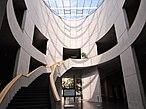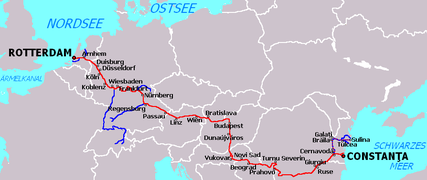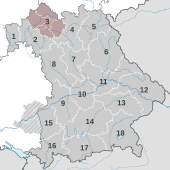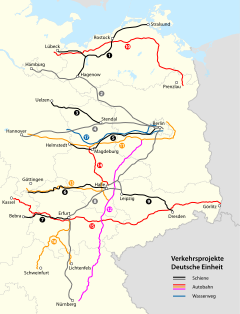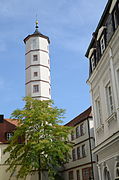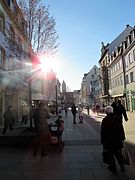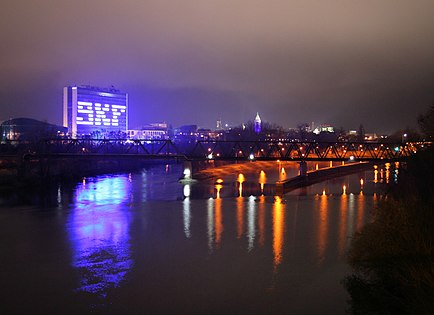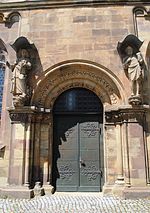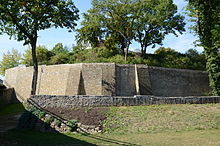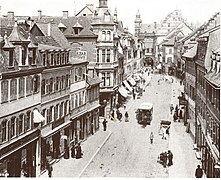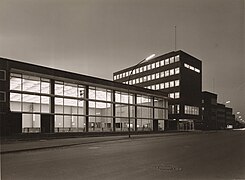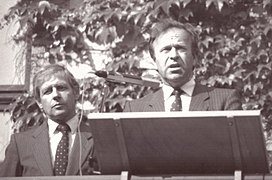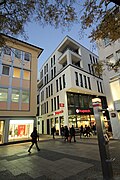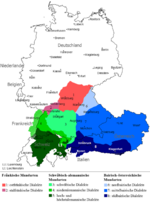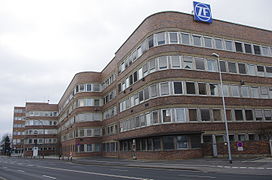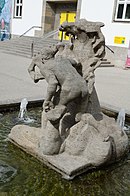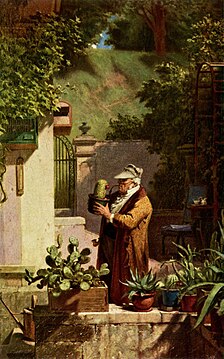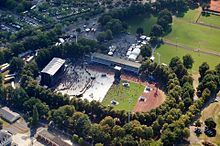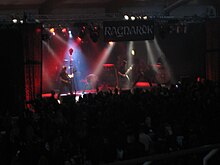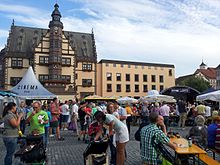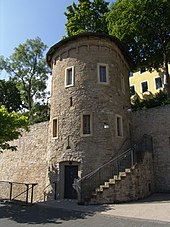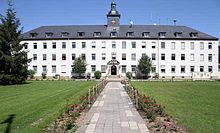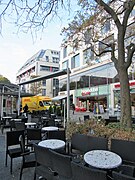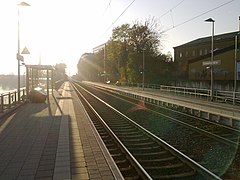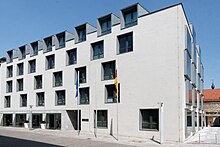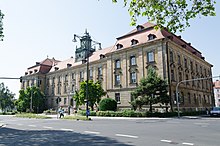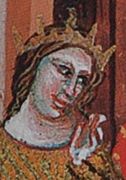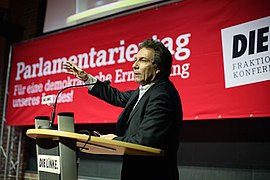Schweinfurt
| coat of arms | Germany map | |
|---|---|---|

|
Coordinates: 50 ° 3 ' N , 10 ° 14' E |
|
| Basic data | ||
| State : | Bavaria | |
| Administrative region : | Lower Franconia | |
| Height : | 226 m above sea level NHN | |
| Area : | 35.7 km 2 | |
| Residents: | 53,426 (Dec. 31, 2019) | |
| Population density : | 1497 inhabitants per km 2 | |
| Postcodes : | 97421, 97422, 97424 | |
| Area code : | 09721 | |
| License plate : | SW | |
| Community key : | 09 6 62 000 | |
| LOCODE : | DE SCW | |
| NUTS : | DE262 | |
| City structure: | 15 districts with 23 districts |
|
City administration address : |
Markt 1 97421 Schweinfurt |
|
| Website : | ||
| Lord Mayor : | Sebastian Remelé ( CSU ) | |
| Location of the city of Schweinfurt in Bavaria | ||
Schweinfurt ( [ ˈʃvaɪ̯nˌfʊʁt ] ; possibly from Old Dutch Swin , Schweinfurterisch : Schweifert ) is an independent city in the administrative district of Lower Franconia in the Free State of Bavaria . The most important industrial city of Northern Bavaria and port city on the Main is the regional center , administrative seat of the district of Schweinfurt , part of two state authorities and a university town . As a German exception, Schweinfurt consists almost exclusively of the core city , which is why the number of inhabitants does not provide a benchmark for comparison. The agglomeration has 100,200 inhabitants (2018) and the catchment area of the city 759,000 inhabitants. It includes the Main-Rhön region and the central part of southern Thuringia .
Schweinfurt was settled in prehistoric times and was first mentioned in a document in 791. The margraves of Schweinfurt lost their national importance 1000 years ago. From the 12th century to 1802 Schweinfurt was an imperial city , in the early modern times a humanistic center and in 1770 industrialization began . During the Second World War , the city was fiercely contested for its key industry ( roller bearings ), was sidelined by the division of Germany and in the middle of the Federal Republic of Germany as a new motorway junction due to reunification .
After overcoming the structural crisis around 1992, the city was not de-industrialized and has the highest job density (2015) and the third highest gross domestic product per inhabitant in Germany (2014). The largest rolling bearing group in the world SKF , the second largest Schaeffler and the third largest automotive supplier in the world ZF Friedrichshafen and the DAX group Fresenius Medical Care have their largest plants in Schweinfurt.
The crank - bicycle was invented in the city on the Main by Philipp Moritz Fischer (1853), the bicycle freewheel (1889) and the coaster brake (1903) both by Ernst Sachs and the inline skates as a series product by SKF (1978). In 1652 the oldest permanent natural research academy in the world was founded in Schweinfurt, the German Academy of Natural Scientists Leopoldina ; Today it is based in Halle (Saale) and became the National Academy of Sciences in 2008.
geography
location
The Schweinfurt region is located in the middle of the German-speaking area ( DA-CH region) and has become a logistics location . Since Brexit , the center of the European Union has been 30 km northeast of Schweinfurt. There are three international airports within a 120 km radius . Schweinfurt lies at the beginning of the Main Triangle , which is followed downstream by the Main Square (see lower middle map). Not far west of the city, the 50th degree of latitude intersects the 10th degree of longitude and forms the only point of confluence of a main degree of latitude and longitude in Germany ( confluence monument ). The Schweinfurt area is surrounded by the Haßberge , Steigerwald , Spessart nature parks and the Rhön biosphere reserve . Steigerwald , Gramschatzer Wald and Rhön are within sight . Schweinfurt is located in a large area of high contrasts, in the south with the summer hot Main Franconian plateau and in the north with the low mountain range , with international winter sports in Oberhof in the Thuringian Forest .
Schweinfurt is on the European Canal ...
... in the middle of the catchment area of
the Main ...... and on the northeast edge of the Schweinfurt basin
Right: Schweinfurt basin with city park . Left: Schweinfurt Rhön with Mainberg Castle
The topography of the urban area combines typical, continental European features: the city center is north of the river, the port south, working-class quarters , large-scale industry and the main train station are relatively compact in the west towards the Rhine and the bourgeois quarters on hills in the east. The east and north of the city are close to nature on the Main meadows and the Schweinfurt Rhön (see top picture on the far right). The lowest point of the urban area is in the southwest on the Main at 202 m above sea level. NHN , the highest in the north in the Schweinfurt Rhön at 343 m above sea level. NHN .
Spatial planning
Schweinfurt is a regional center and forms the core of the only agglomeration area of the Main-Rhön planning region, an otherwise rural region. Main-Rhön (No. 3) is one of 18 planning regions in Bavaria . The landscaped region (see: location ) is considered the Bavarian spa region, with five spa baths; Bad Kissingen is located 20 km north of Schweinfurt .
Hydrology
The built-up urban areas are flood-free, with the exception of short-term, small-scale street flooding caused by heavy rain . Because the Main widens near Schweinfurt (see: Waters ) and the city center is on a pedestal approx. 10 to 15 m above the water level of the Main. On the Main and in the surrounding area, however, floods and heavy ice repeatedly caused major damage, especially in 1845 and 1909.
Geology and tectonics
The geology of the urban area ranges (from older / below to younger / above) from the hard limestone and marl stones of the Upper Muschelkalk, to the softer clayey - marbled Untereuper (Lettenkeuper) interrupted by individual sandstones and limestone banks , to the soft claystones of the Gypsum Keuper .
The tectonics of the urban area is characterized by the Kissingen - Haßfurt fault zone running northeast of the city center from northwest to southeast , which separates the uplift area of the Kissingen-Haßfurter saddle from the Schweinfurt Mulde.
New centrality
Since the fall of the Iron Curtain , the changed wirtschaftsgeografische location Schweinfurt fundamentally. In 2005 the A 71 Erfurt –Schweinfurt was completed as the German Unity No. 16 traffic project and the most expensive motorway in Germany. Since 2017, Berlin has been accessible by train in under three and a half hours thanks to the 10 billion euro German Unity No. 8 transport project, and even before that, Munich was possible from 2 hours 33 minutes and Hamburg from 3 hours 57 minutes via two nearby high-speed lines with ICE stops in Bamberg and Würzburg . Berlin and Munich are about three quarters of an hour faster from Schweinfurt than from Frankfurt a. M. reachable. As part of the DB long-distance traffic offensive, Schweinfurt is expected to receive a direct IC connection through the new IC Bamberg - Schweinfurt - Würzburg - Stuttgart - Tübingen in December 2028 .
New centrality in Schweinfurt through German reunification and new transport projects
|
Dortmund 350 km |
Kassel 200 km 10 ° |
Erfurt 160 km |
|
Frankfurt a. M. 160 km Main 50 ° Würzburg 45 km |

|
Bayreuth 120 km 50 ° Main Bamberg 55 km |
|
Stuttgart 190 km |
10 ° Ulm 230 km |
Nuremberg 120 km |
Berlin (City-West) via A 70: 450 km, via A 71: 442 km
The above kilometers relate to the distances between the city centers when driving on motorways
Most of the motorways with the 7 as the first digit lead in the direction of Schweinfurt or in the opposite direction. 5 km west of the Schweinfurt / Werneck motorway junction , the 50th degree north latitude (see above: 50 ° ), which corresponds to the Main line and A 70 , intersects the 10th meridian east longitude (see above: 10 ° ) which is identical to the north-south - Axis of Europe Denmark - Northern Italy and the A 7 is.
Waters

The city's water area covers around 170 hectares (2020). Between the city center and Sennfeld of there up to 170 m wide are Main and two (former) tributaries: the bayou Saumain and the Backwater Sennfelder lakes wreath . They form a water complex up to 800 m wide with islands in between and a larger peninsula. The Wern flows through the northwest of the urban area in an arch and the Marienbach and Höllenbach flow from the Schweinfurt Rhön into the Main, and the Zellergrundbach flows into the Marienbach there. On both sides of the southern city limits, there are several dredging and natural lakes and main bays with bathing facilities and some fish ponds. (See also: hydrology and leisure )
See also: Main islands in Schweinfurt and Main bridges in Schweinfurt
Forests, parks and protected areas
Despite tight political boundaries, there are relatively extensive forests within the urban area ( urban forest and hospital foundation ), with a total area of 1,756 hectares. The forest areas are mostly in the northeast on the heights of the Schweinfurt Rhön. A smaller part of the forest has a completely different character. It is 100 meters lower, in the flat, winter-mild lowland south of the Main, surrounded by lakes, as part of the Schwebheim Forest. Deciduous forest dominates, and pines can also be found on the sandy soil of the Schwebheim Forest .
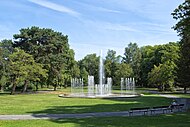
|
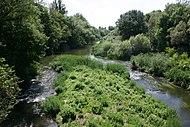
|
|
|
Weir systems with water features
|
NSG Saumain in the city of Schweinfurt , near the city center
|
There are 25,000 city trees on streets and in parks, including around 6,600 maple trees , 4,000 linden trees , 2,000 oaks , 1,830 hornbeams , 1,800 ash trees , 1,140 plane trees and 900 robinia , as well as nine allotment gardens with a total of 40.5 hectares, which is why Schweinfurt is a green city .
The weir systems opposite the old town are among the oldest botanical gardens in Germany. They stretch for 2 kilometers along the Main, at the edge with partially primeval forest -like forests . The old town is largely surrounded by ring systems. There is also the green area on a mountain of rubble from the last war in the Musikerviertel , the Seinäjoki -Park at the Deutschhof above the Höllental valley and the ring area around the quarry pond at the Schwebheimer Wald.
The tradition of the zoological gardens in Schweinfurt can be traced back to the middle of the 19th century. In 1966, the oak wildlife park with the first animal enclosures was opened in the city forest and expanded over the decades. Today 500 animals live on 18 hectares in the wildlife park, which merges into the forests of the Schweinfurt Rhön, cut through by valleys.
In 2026, Schweinfurt is expected to host the Bavarian State Horticultural Show .
A nature reserve , two landscape protection areas , two FFH areas and a geotope are located in the urban area .
See also: List of nature reserves in the city of Schweinfurt , list of landscape protection areas in Schweinfurt , list of FFH areas in the city of Schweinfurt and list of geotopes in Schweinfurt
Viticulture
The local viticulture has hardly any economic but still cultural significance. The large vineyards with 3.54 hectares of planted vineyards (2017) belong to the Volkacher Mainschleife area of the Franconian wine-growing region .
Viticulture has been practiced in Schweinfurt for over 1000 years. In the 19th century it was an important wine-growing and wine trading town, 1802 with around 320 hectares of vineyards. Eastern parts of the city are located on former vineyards. Goethe appreciated the Schweinfurt wine and had large quantities delivered. In 1902 phylloxera appeared in Franconia and hit the Schweinfurt area particularly hard.
Since the 1980s, viticulture with the leading variety Silvaner has been practiced again in the historic Peterstirn and Mainleite vineyards . Due to the almost complete interruption of viticulture, the vineyards were spared from being assigned to large vineyards and from the major land consolidation in the 1970s with the destruction of historical structures.
climate
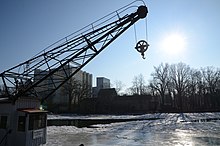
The rainfall is just over 600 mm per year for West German ratios low, due to the location east of the country back Rhon - Spessart , on the leeward side (Schweinfurt dry plate). Continuous rain has always been a maximum of half a day. In midsummer there are often thunderstorms of heat, which is why Schweinfurt became “Germany's lightning capital” in 2015 with 4.5 lightning strikes per square kilometer.
The winters are sometimes cold, the transition seasons are relatively mild for Bavarian conditions due to the low altitude and the summers are mostly warm. Spring will soon arrive in the Schweinfurt Basin and is very pronounced. The moderate continental climate does not occur anywhere else in West Germany , but it is widespread in East Germany . Schweinfurt and Berlin key climate data are almost identical.
Due to global warming , the severe winters that occurred up until the 1980s were rapidly reduced. The summers were sometimes tropical hot, especially in the south, in the Schweinfurt Basin, but have always been somewhat more moderate in the north in the Schweinfurt Rhön , with winters tending to be more pronounced.
In the urban climate , the heat island effect is mitigated by favorable topographical factors and is less than in neighboring Würzburg, for example . Schweinfurt is not in a basin , has a lot of green and water and the main valley runs in the main wind direction from east to west.
City structure
The urban area consists almost exclusively of the core city (for reasons see: incorporation ). There is no official city structure . The urban area was only internally divided into 26 statistical districts and these were assigned to 15 districts (blue bold on the list below). It remains unclear whether the old town also forms its own district (see: Old Town ).
- Old town ,
crooked alley - City center ,
justice center u. Kaufhof
- City center west , Luitpoldstrasse
- Deutschhof ,
Kreuzbergstrasse
| No. | Name of the statistical district / suburb | Residents Dec. 31, 2015 |
Foreigners (%) |
Dual nationals (%) |
|---|---|---|---|---|
| 11 | Old town | 2,529 | 17.7 | 6.9 |
| 12 | Downtown -West | 4,291 | 29.4 | 15.7 |
| 13 | Downtown north | 3,994 | 23.0 | 13.1 |
| 21st | Bergl | 9,162 | 18.8 | 23.9 |
| 22nd | Musicians' quarter | 3,103 | 20.4 | 20.1 |
| 31 | Northwestern part of the city | 3,314 | 19.1 | 15.5 |
| 32 | Garden city | 2,787 | 6.6 | 9.4 |
| 33 | Northern part of the city | 3,024 | 11.9 | 16.6 |
| 34 | Haardt | 1,779 | 7.4 | 17.4 |
| 35 | Donkey height | 2,561 | 4.3 | 13.9 |
| 41 | Hochfeld / Steinberg | 5.126 | 7.6 | 10.8 |
| 42 | Northeastern part of the city | 2,734 | 7.4 | 8.2 |
| 43 | Deutschhof South | 1,855 | 6.1 | 26.3 |
| 44 | Deutschhof-Mitte | 1,454 | 9.6 | 27.4 |
| 45 | Deutschhof-Ost | 962 | 7.3 | 25.7 |
| 46 | Deutschhof-North | 963 | 6.0 | 14.6 |
| 47 | Deutschhof-Zeilbaum | 784 | 1.9 | 11.4 |
| 51 | Hafen-Ost | 244 | 7.8 | 7.4 |
| 52 | Harbor West | 22nd | 50.0 | 4.5 |
| 53 | Schweinfurt-Süd / Baggersee | 4th | 0.0 | 0.0 |
| 54 | Main valley | 2 | 0.0 | 0.0 |
| 61 | Oberndorf South | 1,135 | 11.3 | 9.7 |
| 62 | Oberndorf-Mitte | 1,326 | 16.1 | 13.7 |
| 32.5, 36, 63 | Various peripheral areas | 47 | 2.1 | 25.5 |
| Schweinfurt as a whole | 53.202 | 14.6 | 16.2 |
Cityscape
Despite its large-scale industry, Schweinfurt is an organically grown city. After the war, no planned, rapid reconstruction was necessary, which gave scope for later stylistic epochs. The cityscape is free of industrial sprawl , old railway areas and fallow land.
The southwest around the main station is characterized by industrial clinker buildings of the New Objectivity of the 1930s (see picture: Profanbauten , right picture of the picture bar). Only large industrial and commercial parks are located south of the Main. Together with approx. 6 square kilometers, both areas form the largest contiguous industrial area in Bavaria. Industrial buildings from the early days of the city near the city center were demolished for office buildings and the Schweinfurt city gallery . Behind the southern industrial skyline, the old town surprises with historical evidence of the imperial city past.
The development from a historic small town through industrialization to the regional center for half a million inhabitants is reflected in the contrasting cityscape of the inner city . It changes from east to west (in the lower picture bar from left to right). Old Franconian alleys in the eastern old town merge into mid-town , sometimes chaotic structures around the Roßmarkt , right up to the big cityscape in the western part of the city. The Rückert-Center is an exception in the east. (See also: architecture )
Rückertstrasse ,
Rückert-CenterOld town ,
market with old town hallOld town,
former commercial districtOld town,
SpitalstrasseCity,
Jägersbrunnen
with Iduna high-riseWestern Gründerzeitviertel ,
Luitpoldstrasse
The skyscraper of the German headquarters of SKF (1960–1962) by A. Kubitza, located on the Main, was modeled on the UN headquarters on the East River in New York . Up until the 1960s there was a neon sign "UN" switched on by room light behind the windows. It also served as a model for the blue SKF logo, which was converted to LED technology in 2014 as part of a general renovation of the high-rise building .
^ UN headquarters
(1951) on the East River
Naming
According to Wolf-Armin von Reitzenstein, it was not the pig but Swin who gave the city its name. The word probably does not come from Old High German , but was brought back by the Franks from their original areas around the Meuse and Schelde . In Dutch , Zwin [ zʋin ] denotes a creek , a watercourse in the mudflats and marshes . Swin literally means to decrease (to shrink) and in this context refers to the shallow water of a ford . The word was also used in Old Saxon , as indicated by several places called Swinford on the British Isles , as well as Swinoujscie on the Swine .

The old town village was Schweinfurt's first settlement. It was east of today's old town between Marienbach and Höllental , at the level of the Sennfelder Seenkranz , a former tributary of the Main. The ford is believed to be there. Fords were preferred to be built on branches of the river , with safer river crossing in stages. The name of the settlement is documented as follows:
|
|
|
"If you had Mainfurt, you could have called Weinfurt, because you lead wine, but it should be Schweinfurt, Schweinfurt." Friedrich Rückert , born in 1788 in Schweinfurt
history
The high point of the history of Schweinfurt, with national influence, dates back 1000 years when the Margraves of Schweinfurt supported later emperors of the Holy Roman Empire twice . The city only regained greater national importance 900 years later, as the center of the European rolling bearing industry .
The early history of the town is not documented in a coherent manner, as it is based on three historical locations and the originally self-sufficient Fischerrain . These four places run along the Main for 2.2 kilometers (from east to west): Burgberg Peterstirn (today winery), Dorf Altstadt (desertification in today's northeastern part of town ), Reichsstadt (today's old town ) and Fischerrain (in today's old town).
prehistory
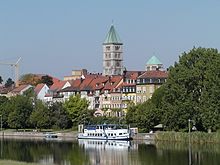
During the most recent glaciation phase, the Würm Ice Age , which began around 10,000 BC. Ended in BC, the Schweinfurt area was in the middle of the ice-free, approx. 250 km wide corridor between the Alpine and Scandinavian ice sheets . The first evidence can be found in the neighboring suburb of Dittelbrunn , where a Mesolithic find (around 10,000 BC) is documented. Traces of settlement since 7500 years (beginning of the Neolithic Age ) can be traced almost completely within today's urban area . From the band ceramic culture (5500 to 5000 BC) with two long houses on the Eselshöhe adjacent to Dittelbrunn , the stitch band ceramics (4900 to 4500 BC), other epochs of the Neolithic (up to 2200 BC), the Urnfield Age (1300 to 800 BC), the Hallstatt period (800 to 450 BC) on the Fischerrain , up to the Latène period (450 BC to the year 0 ) also on the Fischerrain.

A settlement by Celts around 500 BC. Chr. And Teutons is proven at the Biegenbach, between Bergl and Geldersheim . During the Drusus campaigns , the Romans collided in 10 BC. BC to the Schweinfurt Main knee.
The first settlement known by name in the Schweinfurt urban area is the Affeltrach desert on the banks of the Wern , on the northern edge of Bellevue . The name is probably derived from the Old High German word for apple tree , aphaltar . The village was probably founded by Germans in pre-Christian times.
Also in the area of the medieval village Altstadt (see: naming ) there are prehistoric finds of a longhouse made of ribbon ceramics and a fishing settlement from the Iron Age from the 5th to 2nd century BC. It was 1.3 kilometers up the Main or east of the former fishing settlement of Fischerrain. A continuous settlement of the area of the old town from the band pottery to the beginning of the early Middle Ages has not been proven.
Early middle ages
From the village of Old Town early medieval scattered finds evidence from the Merovingian period (5th to 8th century. N. Chr.) And finds of 800 to 1200 n. Chr. From the Early and High Middle Ages .
The Franks defeated the Thuringians in 531 and then overlaid the village of Altstadt . This was linked to the Christianization , which began in Franconia at the end of the 7th century ( Kilian's Church on the western edge of the old town ).
The existence of Schweinfurt is documented around 750. In 791, Schweinfurt was first mentioned in the Codex Edelini of the Weißenburg monastery , in which the monastery's possessions were listed four decades earlier. Oberndorf , which belongs to Schweinfurt today as well as during the imperial city era , was first mentioned in a document in 741.
The margraves of Schweinfurt built their ancestral castle in the 10th century on the Peterstirn , above the Höllental, not far east of the old town . At an unknown point in time, an imperial castle was built above the margraves' castle , with a moat that is still preserved today. Schweinfurt gained importance as early as 941, when Berthold was named as the first member of the margraves. He occupied an important position in the central imperial territory, the Duchy of Franconia . Berthold gave King Otto I (r. 936–973) valuable weapon aid against rebellious tribal dukes. As a thank you, Berthold received the counties for the Folkfeld and Radenzgau and the margraviate for the Nordgau , roughly today's Upper Palatinate, from Otto . As a result, he and from 980 his son Heinrich von Schweinfurt (called: Hezilo ) were the most powerful, secular nobles in what is now northern Bavaria, with a chain of castles extending into the Bavarian Forest . Hezilo supported Heinrich II. (R. 1002-1024) in the election of the king in 1002 and was promised the ducal dignity of Bavaria . After the election, Heinrich II did not keep the promise. This led to the Schweinfurt feud in 1003 . With the exception of the Peterstirn Castle Hill, Hezilo lost all of his possessions. The confiscated royal estates formed the core of the new Bamberg diocese . The Schweinfurt noble family, with Judith von Schweinfurt as the legendary, central figure of Schweinfurt history, died out in the male line 1057.
High Middle Ages
At the beginning of the High Middle Ages , Schweinfurt degenerated into an insignificant village. The nunnery (later Benedictine monastery ), which was founded by Hezilo's mother Eila in 1003 as an atonement for Hezilo's uprising against Heinrich II, was neglected and came into the possession of the Hochstift Eichstätt in 1112 with the village of Altstadt . Schweinfurt now experienced Catholicism in its purest form.
Today's old town around the market square was built in the 12th century, during the Staufer era . It was built 1 kilometer west of the old town , on the other side of the Marienbach and immediately east of the initially independent fishing area . There are two views on this, a gradual relocation of the old town or a founding town in competition with the Eichstättischen settlement by Emperor Friedrich I. Barbarossa (ruled 1152–1190), as Civitas Imperii ( imperial city ), using existing royal property . The classic medieval town plan (street cross on the market square with four quarters ) and the lack of evidence of a town charter speak for a founding town. Important trade routes converged there, from Obermain , Untermain , Erfurt and northern Germany . The Zurich district was the first to emerge . All residents of the old town had been relocated by 1524 , which then fell into disrepair.
Late Middle Ages
In the struggle for dominance in Main Franconia between the Hennebergers and the Bishop of Würzburg , the city was destroyed between 1240 and 1250 ( first city ruin ). It is controversial whether this destruction took place in the old town and was a reason for the building of the imperial city or whether it already took place there. In a letter from King Wilhelm of January 9, 1254, it is said that Schweinfurt was formerly an imperial city (... Swinforde, que olim imperii civitas fuerat) . It remains unclear whether rights were ever withdrawn from the city or whether reference is only made to the destruction. However, this letter is the first documentary evidence of Schweinfurt as an imperial city and thus also as a place with city rights . The imperial city of Schweinfurt built the city fortifications, first mentioned in 1258 and partly still preserved. In 1282, Schweinfurt was confirmed as an imperial city by Rudolf von Habsburg (r. 1273–1291). In 1309, Schweinfurt was pledged to the Hennebergers who maintained an imperial castle in Zurich from 1310 to 1427 , the castle chapel ( choir of St. Salvator ) still partially preserved.
|
In 1436 Oberndorf was acquired. 1437 was due to good economic development also the possessions of the Teutonic Order , including the villages of Zell and Weipoltshausen , with all vogtei union acquired rights. The citizens of these places received no citizenship , but were subjects of the city-state .
Early modern age
The Reformation joined Schweinfurt 1542 on. That was relatively late, as the city was surrounded by the Würzburg monastery and military attacks had to be expected if there was a change of denomination. The patron of the city, Count Wilhelm von Henneberg, did not offer enough support for this.
During the Second Margrave War , the city was sacked and set on fire in 1554. This went down in the city's history as the “Second City Disaster”. The reconstruction dragged on until 1615. With the exception of the fortifications that were later modernized, the shape of the old town remained almost unchanged until the early 19th century. In 1609 the city joined the Protestant Union . After the acquisition of the Madenhausen exclave in 1620, the territory of the imperial city comprised 53 km², (for example, today's urban area 36 km²), which had an extension of 17 km from southwest to northeast. This resulted in an almost continuous Protestant corridor from Schweinfurt via the knightly canton of Baunach through the Hochstifte Würzburg and Bamberg to the Protestant Duchy of Saxony .
During the Thirty Years' War (1618–1648) the imperial city opened its gates to the Swedish King Gustav II Adolf (reigned 1611–32) in 1632. The Swedish General Field Marshal Karl Gustav Wrangel set up his headquarters here and expanded the city wall into a modern fortification system with upstream entrenchments (see: 2nd lower figure from the left). The Swedish interim government ended in 1634. In April 1647, Swedish troops conquered the city with some damage, which otherwise survived the Thirty Years War unscathed. The two best-known images of the imperial city (1st and 2nd lower image from the left) come from the time immediately after the Thirty Years' War.
- Schweinfurt in the early modern times
Reichsstadt Schweinfurt ,
M. Merian, Frankfurt a. M. (1648)Spitalstrasse
(photo before 1896)Outer Spitaltor
and Innerer Spitalturm
(photo before 1896)
Failed university foundation
On the instructions of Gustav Adolf II, the Gustavianum grammar school , today's Celtis grammar school , was founded in Schweinfurt in 1632 . He is also wanted in the city, as a counterbalance to the Protestant University of Wuerzburg , one from the Catholic dogmatism freed, only the science undertook University found. During the Thirty Years' War he took Geldersheim and 17 other towns from the Würzburg monastery and donated them to the imperial city in early 1632 to finance the elite school. The project was thwarted by his death at the end of 1632 in the battle of Lützen and finally by the end of local Swedish rule in 1634, when the 18 towns had to be returned to the bishopric.
Spiritual life
The Latin school was founded in the 13th century, from which famous humanists emerged : Konrad Celtis (1459–1508), crowned the first German poeta laureatus in 1493 , Johannes Cuspinian (1473–1529), Rector of the University of Vienna in 1500 and Johannes Sinapius (1502– 1560), 1534 professor of medicine at the University of Ferrara . Olympia Fulvia Morata (1526–1555) from Ferrara gathered a circle of humanistically educated friends in Schweinfurt. She was praised as the new Sappho and appointed to Heidelberg University in 1555 .
In 1652 the German Academy of Sciences Leopoldina was founded in Schweinfurt , which was promoted to the National Academy of Sciences in 2008 (see: the place where the Leopoldina was founded ).
Start of industrialization
The industrialization of the city began in 1770 , with a continuous 250-year industrial history to this day, without the phases of de-industrialization that happened to all other Franconian industrial cities. The chemical and paint industry began in 1770 with the construction of Wolf's white lead mill on today's weir systems . According to Ferdinand Gademann (1880–1969), it is said to have been the oldest German white lead factory . In 1780 it was taken over by Johann Martin Schmidt. Other factory-like systems were built on Bellevue and in the Niederwerrn suburb .
Kingdom of Bavaria
Through the Reichsdeputationshauptschluss , Schweinfurt came to Bavaria in 1802 . 4,000 people demonstrated in vain against the Anschluss at Roßmarkt . After belonging to the Grand Duchy of Würzburg (1810-1814), Schweinfurt fell to the newly founded Kingdom of Bavaria in 1814 . The villages belonging to the imperial city territory were spun off. As a result, Schweinfurt lost over half of its territory. In the German War on July 10, 1866, Prussian troops defeated the Bavarians in the Battle of Kissingen , who fled to Schweinfurt. The Prussians followed them to near the city, but received the order there to march against Frankfurt am Main . Schweinfurt was at no time under the influence of Prussia .
In 1852, with the opening of the Ludwigs-Westbahn from Bamberg to the city station, it was connected to the railway network. In 1874, 2.5 kilometers further west, the main train station was opened in the then still independent Oberndorf as "Centralbahnhof". The Schweinfurt tram , as a horse-drawn tram and the first municipal tram in Bavaria, connected the main train station with the city center from 1895 to 1921.
- Schweinfurt in the early days of the Kingdom of Bavaria
Schweinfurt tram (horse-drawn tram)
in HauptbahnhofstrasseMain at the Maxbrücke around 1902
with pumping station and millsFichtel & Sachs AG Plant 1
in 1913 (from 1929 VKF )
Weimar Republic

|

|
|
|
Poster against the Soviet Republic 1919: “Out with you! There's no anarchy at ons "
|
Advertisement from Fries & Höpflinger AG
|
When the first Bavarian Prime Minister Kurt Eisner was murdered , his colleague Benno Merkle and later Lord Mayor of Schweinfurt ( MSPD , 1920–1933) narrowly escaped being shot. After the proclamation of the Munich Soviet Republic in 1919 by the “Workers and Soldiers Council” (ASR), the Schweinfurt trade unionist Fritz Soldmann became “People's Representative for the Interior” and sent a telegram to the city to join the Soviet Republic. Thousands of people were present at the proclamation on the Maininsel Bleichrasen . Civil war-like fighting broke out in the city, with some dead. The ASR took an armored train under fire at night and shot at the main station from the Oberndorf water tower . “ The workers' stronghold on the Main was Soviet for a few days. "
In 1929 the German rolling bearing industry was reorganized in a cartel under the leadership of the Swedish SKF as well as Ernst Sachs ( Fichtel & Sachs AG ) and Georg Schäfer ( Kugelfischer ), which turned out to be the point of departure for the location. Sachs sold its rolling bearing division to SKF, which had been pursuing an aggressive expansion strategy since 1925. SKF acquired the Schweinfurt-based Fries & Höpflinger AG and also plants in Berlin and Krefeld , which merged to form the United Kugellagerfabriken (VKF, SKF from 1953), with headquarters in Schweinfurt. On the supervisory board sat u. a. Ernst Sachs, Peter Klöckner , Fritz Thyssen and Günther Quandt . VKF dominated 80% of the German market. The only remaining German competitor was Kugelfischer. SKF has now gradually shut down the plants in Berlin and Krefeld. The German rolling bearing industry was now completely controlled from Schweinfurt, from two headquarters that were only 500 m apart.
In the early 1930s, Adolf Hitler was not very popular in the SPD- dominated workers' city. On his second visit to the city in 1932, only about 9,000 people came, while over 70,000 people had previously heard him in Coburg . Hitler is said to have been extremely angry in Schweinfurt, also because many "Ugh" shouts accompanied him at the entrance.
National Socialism
From 1934 onwards, the economic depression was followed by an economic boom supported by job creation programs and military armaments. The number of employees in the large metal processing companies rose to 20,700 by 1939. Spacious residential complexes, the Willy Sachs Stadium and barracks were built.
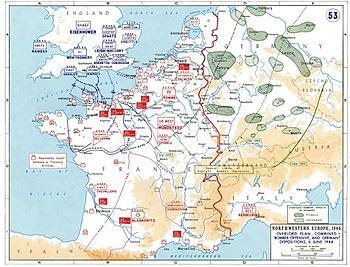
Schweinfurt (checkered hatching in the German center) the only primary target (was Primary ) of the Allies in Bavaria
The Second World War broke out in the middle of the building boom. Production was maintained with great effort, with factories partially protected against bombs like bunkers. Parts of the production were relocated to other locations. 1942 began Todt Organization the plaster tunnel Neckarzimmern to expand massively for the bearings production of sales promotion. Forced laborers from the Neckarelz concentration camp in the immediate vicinity were used to drive the tunnel and to assist in production.
The aerial warfare over Schweinfurt was different from other cities. Not the local population, but the attacking air force experienced a fateful day. The local, war-essential rolling bearing industry was a key industry for tank and aircraft construction. According to Albert Speer, if the Schweinfurt industry failed, the war would have been over in two months, which is why the city had the best air defense in Germany. The city was destroyed by 40% and the industrial area by 80% in 22 air strikes, which is known as the Third Ruin of the City . However, no firestorm was kindled, in contrast to neighboring Würzburg , which was 80% destroyed in an attack. During the first attack on Schweinfurt on August 17, 1943, the United States Army Air Forces suffered major losses as part of Operation Double Strike ; the second attack on October 14, 1943 resulted in the largest air defeat in its history. The Black Friday (Black Thursday) resulted in 600 deaths among bomber crews. Air raids on Schweinfurt were feared by the Allies from then on. A color film by the Americans testifies to the first attack (see: Videos ).
On April 11, 1945 the Americans marched into the city, two barracks were occupied immediately and finally the US Army Garrison Schweinfurt was founded.
Federal Republic of Germany
During the Cold War , the US site in Schweinfurt had the highest concentration of US combat units in the Federal Republic of Germany. In the economic boom big industry boomed in 1960 were foreign workers recruited. The big three ( Fichtel & Sachs , SKF , FAG Kugelfischer ) were among the 100 largest companies in Germany and the football city ( 1. FC Schweinfurt 05 ) was well known.
Under Lord Mayor Georg Wichtermann ( SPD , 1956–1974), in the city ruled by the SPD with an absolute majority, several new city districts were created and, thanks to high trade tax revenues, a generous infrastructure . With the jump over the Main in 1963, the new port (1963), the industrial area Hafen-West and the industrial park Hafen-Ost were developed. In 1971, today's Würzburg-Schweinfurt University of Applied Sciences opened .
The time of Lord Mayor Kurt Petzold (SPD, 1974-1992) was marked by consolidation, the oil crisis and recessions , with job cuts in large-scale industry. The renovation of the old town began in 1979, the Leopoldina Hospital was opened in 1981 and the Schweinfurt joint power station in 1990 .
With Gudrun Grieser ( CSU , 1992–2010), the CSU succeeded in appointing the Lord Mayor for the first time. The Bavarian Prime Minister Edmund Stoiber (CSU) benevolently accompanied the change of power and parts of the Bavarian State Social Court and the Bavarian State Office for Statistics were moved from Munich to Schweinfurt. From the mid-1990s, the economic situation stabilized, 4,500 new jobs were created in industry and 6,000 in the service sector, and trade tax revenues rose to a record high. Countless, z. Construction projects, some of which were noted in the world of architecture, were implemented. The new Maintal industrial and commercial park (from 1995), the Georg Schäfer Museum (2000), the Maininsel Conference Center (2004), the city library in the Ebracher Hof (2007) and the urban redevelopment west (2009) with the Schweinfurt city gallery and the Kunsthalle Schweinfurt .
Under Lord Mayor Sebastian Remelé (CSU, from 2010), trade tax revenues reached new records. Reserves could be used for the mammoth US conversion project , which is currently one of the five largest military conversion projects in Germany. The i-Campus Schweinfurt and the new Bellevue district deserve special mention . Other plans (in particular the State Garden Show 2026) came under fire and in the 2020 city council elections , the CSU again lost its longstanding dominance.
- Schweinfurt in the Federal Republic of Germany
Mayor Kurt Petzold (l.) At an anti-nuclear rally in the 1980s
Schweinfurt
Art Gallery (1933/2009)City Gallery Schweinfurt (2009)
See also: Schweinfurt industrial history
population
Religions
Religions, total population Schweinfurt 2017
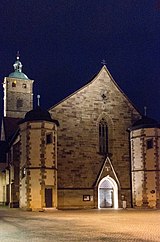
|

|
|
|
Evangelical main church St. Johannis (inherited from 1200)
|
Main Catholic Church of the Holy Spirit (1902)
|
Evangelical regional church
Schweinfurt joined the Reformation in 1542 . Philip I of Hesse , the leading head of the Schmalkaldic League and pioneer of Protestantism , was won over as patron and imperial bailiff . Johann Sutel (called: Sutellius ), who was sent by him , held the first Protestant service in 1542 and drafted church regulations. Catholics were excluded from citizenship until the end of the imperial city period. At the time of the Counter Reformation (1587–1631), around 700 Protestant religious refugees emigrated from the Würzburg monastery to Schweinfurt.
See also: Evangelical Lutheran Deanery Schweinfurt
Regional church community
The Christian Community Schweinfurt of the LKG is part of the Evangelical Lutheran Church in Bavaria and belongs to the Regional Church Community Association (LKG) in Bavaria, which occupies an intermediate position between the regional church and free churches .
Free Churches
In the 19th century there was a hall of the Free Christian Community on Schillerplatz , which was used as a concert hall from 1868 at the latest. Until the 1970s, there was only one Methodist congregation in Schweinfurt , who in the broader sense counted as a Free Church , and one Evangelical Free Church congregation ( Baptists ) and several English-speaking congregations of free churches for members of the US garrison in Schweinfurt . Since then, other congregations have sprung up, both with a pietistic - evangelical and Pentecostal - charismatic character. The first group includes the Baptists, the free church congregation Christians in Action in Oberndorf and the Christian congregation Schweinfurt , the second group the Word of Faith and the Biblical congregation Schweinfurt . Some free churches are represented in the Evangelical Alliance .
Roman Catholic Church
The Catholicism remained for cultural meaningless expression of Schweinfurt. With the introduction of the Reformation, all churches in the imperial city had become Protestant. The Bavarian religious edict of 1803 made it possible to re-establish a Catholic parish in 1806. The Catholic community received the hospital church of the Holy Spirit from the city for their services. With the steady influx of Catholics from the surrounding area, it became too small over time and was broken off. In 1902 the Heilig-Geist-Kirche was completed as a follow -up building and has since been the main church of the Schweinfurt Catholics.
See also: Deanery Schweinfurt-Stadt
Greek Orthodox Church
The Greek Orthodox community holds its services in the basement of St. Anton .
Other Christian communities
In addition, seven-day Adventist congregations , the New Apostolic Church and Jehovah's Witnesses are represented in the city.
Judaism
A Jewish resident of the city can be proven with Abraham von Schweinfurt, mentioned in 1212 . There is also evidence of Jewish families in the city that were affected by both the rint meat persecution of 1298 and the plague pogrom of 1348/49. In 1368 the city of Schweinfurt was granted the privilege of re-admitting Jews within its walls from Emperor Charles IV . In the period that followed, Jews could live relatively freely and safely in return for paying high taxes. The synagogue was located in Judengasse in the old industrial quarter . The medieval Jewish community, which made a living by lending money and trading, came to an end in 1554/55. The Schweinfurt citizens took action against the Jews because they were heavily indebted to them.
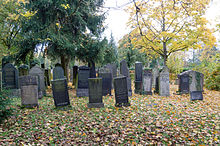
It was not until the Bavarian period after 1814 that Jews were allowed to settle again, who set up a community center in Siebenbrückleinsgasse . The Jewish cemetery was opened in 1874, and in 1969 the last burial took place there. The synagogue was desecrated during the November pogrom in 1938 , then converted into a fire brigade depot and destroyed by several aircraft bombs in 1943. In 1945 the property of the community center was transferred to the Jewish asset management JRSO, which later sold it to the Städtische Sparkasse . Around 1970 the Jewish parish hall south of the synagogue was demolished for the expansion of the Sparkasse parking lot. In 1973 a memorial stone was placed at this point containing two incorrect pieces of information:
- “ Here stood the synagogue of the Israelite religious community in our city. She became a victim of the racial madness on November 9, 1938 - The dead in honor of the memory - The living in memory a. Warning. "
Islam
From the 1960s, Islam gained importance in Schweinfurt, as a result of the immigration of Turkish workers to the large industrial center. This was followed by families who are now in the third generation living in their new home. More recently, migrants of the Islamic faith came from all over the world. There are now five mosques in the city . a. by the communities DITIB , Millî Görüş , IBV and the Arab community. The largest congregation, DITIB, has around 2,500 believers.
See also: Churches in Schweinfurt
Cultural imprint

Despite German central location on the Main Line is Mainfrankenpark ethnically and culturally southern German dominated. It is in the area of Upper German and in the distribution area of the greeting Grüß Gott , one celebrates carnival instead of carnival and plays sheep instead of skat .
However, the more recently largely multicultural core city of Schweinfurt, with a population of almost 50% migration background and 125 nationalities, stands in contrast to the surrounding area, whose districts have the lowest proportion of migrants in West Germany. The Schweinfurter Land is a center of Franconian costume and Franconian customs, with the mixture of Protestant and Catholic places typical of Franconia . The Protestant suburbs were imperial knights or Sennfeld and Gochsheim imperial villages .
language
The in Schweinfurt, and to the outer areas of southern Thuringia spoken Unterostfränkische dialect has much more resemblance to the up to the outermost northeast corner of France reaching southFrankish dialect (see: reddish surface dyeings on the left card), as with the Bairischen (blue surface coloration). Until 1990 this Franconian dialect zone extended over three states, from France to the Federal Republic of Germany to the GDR and until 1945 to the outermost edge of today's Czech Republic .
In Schweinfurt, in contrast to the neighboring Würzburg area, Franconian dialect names are negated, one does not speak Meefränkisch (Main Franconian), but Schweinfurterisch . A noticeable difference is the diminutive in the plural form, with the ending lich instead of li ; z. B. Domestic instead of Häusli ( little house).
Today the Schweinfurt dialect is almost meaningless within the city center (see: Cultural Characteristics ). But even earlier the dialect was spoken less clearly in the city than in the surrounding area, as the language of the simpler people, workers and peasants.
Americans in Schweinfurt

The US Army Garrison (USAG) Schweinfurt became one of the largest US locations in Europe with up to 12,000 Americans (soldiers and civilians) following the closure of many other American military bases in Germany at the beginning of the 21st century. The USAG Schweinfurt built up a civil infrastructure over time that corresponded to that of a small American town (Little America) . As a result of the abolition of compulsory military service in 1973, the US site got a more civil character. With the professional soldiers came many family members, who in the end were in the majority. In addition, the social change in the USA was also noticeable in Schweinfurt, towards a more multicultural society with more African-Americans , Latinos and Asians. In the course of time, a German-American scene also formed, the Schweinfurt jazz musician Ed Sperber should be mentioned here .
The first major restructuring of the German US armed forces was completed in 2014 with the closure of the Schweinfurt site. Several major projects are currently under construction on the former US site.
See also: List of US conversion in Schweinfurt
Social upheavals
Since the 1970s, many younger families as well as long-established citizens left the narrow city limits (for reasons see: Incorporation ) and moved to the suburbs, creating a bacon belt . The western core city , which no longer met the increased German housing requirements, was now determined by segregation , by families with a migration background , which resulted in neighborhoods characterized by ethnicity .
Population development
In 1939 Schweinfurt had 50,000 inhabitants. At the beginning of the 1960s, it was expected that the city in its current area, without incorporation, would grow to 95,000 inhabitants in 2000. But by 1970 the previous high was reached with only 58,500 inhabitants. While almost all other German cities were able to compensate for demographic decreases in population through incorporation , there was not a single incorporation in Schweinfurt (for reasons see: incorporation ). As a result, the population fell to 52,000 by 1987. Then it rose again to 56,000 by 1996 due to the influx of ethnic repatriates . In 2014, the population fell to 51,600, its lowest level since the early 1950s. After that, due to several factors, a change occurred and the population increased, up to 54,032 in 2018. The population statistics do not include soldiers and members of the US Army Garrison Schweinfurt stationed between 1945 and 2014 , at times with 12,000 people.
In Schweinfurt's case, the agglomeration is a better benchmark for the population of other cities. In 1994 it had 105,000 inhabitants, fell to 96,600 inhabitants (May 9, 2011 census) and then rose again to 100,200 inhabitants (December 31, 2018 estimate).
|
|
|
Bold: highest level
Red: lowest level since the beginning of the 1950s
¹ information about the city of Schweinfurt
² census or census ( official population )
³ information from the Bavarian State Office for Statistics (official population)
politics
In the post-war period, Schweinfurt was, alongside Munich and Nuremberg, one of the few Bavarian SPD strongholds in which the party consistently provided the mayor. In the Schweinfurt city council, the SPD had an absolute majority until the 1990s, when the CSU gained the upper hand due to social change . She dominated the city for a decade and a half. However, Schweinfurt remained a center of trade unions and leftists with representatives at state and federal level.
City council
The city council consists of 44 seats. The mayor Sebastian Remelé (CSU), elected directly by the voters, is the 45th member of the city council.
Since 1990, attracted as many places, alongside established parties and groups of voters in the City Council one. In the local elections on March 15, 2020 , the dominance of the CSU was broken and they agreed to work with the Greens .
Lord Mayor
Schweinfurt's mayor is characterized by long terms of office. In the 19th century, Carl von Schultes was in office for 45 years. The SPD provided the mayor from 1920 to 1933 and from 1946 to 1992, who was first appointed by the CSU in Gudrun Grieser (1992-2010). There were six candidates for the mayor election in 2010. Sebastian Remelé (CSU) won the runoff election with 63.4% and was confirmed in office in 2014 with 66.9% and on March 15, 2020 with 58.4%.
Town twinning
Schweinfurt maintains the following city partnerships :
- since 1962: North Lanarkshire , United Kingdom

- since 1964: Châteaudun , France

- since 1979: Seinäjoki , Finland

The North Lanarkshire district was created in 1996 as part of a Scottish administrative reorganization. Schweinfurt's oldest twin town, Motherwell, was absorbed in it.
coat of arms
| Blazon : "A silver eagle in blue." | |
|
Reasons for the coat of arms: The first known coat of arms consisted of a one-headed black eagle on a yellow or gold shield, which heraldically looked to the right, i.e. to the left when viewed from the observer. In the 15th century the eagle was silver on a black background, in 1608 the colors silver on purple were mentioned. Later it was again a black eagle on a gold background. Since 1771 the colors have been silver on blue.
The best-known depiction of the coat of arms was on the Mühltor until 1875 . Since the eagle turned its head towards the viewer, many took it for an owl; Friedrich Rückert dedicated a few verses to him in The Visit to the City . |
Incorporation

No suburbs were incorporated into Schweinfurt during the Bavarian territorial reform . There are different reasons and political blame for this. On May 1, 1978 Grafenrheinfeld only had to cede an unpopulated area of 2 square kilometers to the city of Schweinfurt as a space for its industrial development ( Maintal ). Compared to almost all other German cities, Schweinfurt therefore comprises almost only the core city and became the smallest independent city in Germany.
Only Oberndorf , which belonged to the imperial city of Schweinfurt from 1436 to 1802 , was incorporated into the city in 1919, when it had already completely merged with the city, adding 8.18 km² with 3,886 inhabitants. The decisive factor was the local large-scale industry, most of which, including the main train station , was in Oberndorf's municipal area. Oberndorf was no longer able to guarantee the water supply for large companies. In order to avert the threatened incorporation, the village had a water tower built in 1911/12. However, large industry rejected the very hard water because of the high risk of calcification.
More recently, the territorial reform of the 1970s and its consequences for the city have returned to the media focus.
architecture
Secular buildings

|

|
|
|
Classicist palace (1870) ...
|
... Rückertstraße 28 u. 30 (left)
|
The Renaissance is the defining historical style of the Protestant imperial city in the old town . The Schranne was built as a granary in 1560. The old town hall (1570–1572) is considered a brilliant achievement of the profane German Renaissance. The old grammar school (1582–1583) was the domicile of the Gustavianum grammar school ( Celtis grammar school ) from 1634 to 1881 ; the armory (1589-1591) was the arsenal of the imperial city. The scrap tower (1611) is a stair tower in front of a Renaissance town house, which was raised by four floors to a scrap tower in the 19th century . Industrialists' villas were built on Kiliansberg around 1900.
Numerous well-known architects of the 20th century were associated with the city. Theodor Fischer , who was born in Schweinfurt, was involved in the planning of the Berlin Reichstag building, eventually distanced himself from historicism , laid the foundations for the Bauhaus manifesto and built the Wirsing Villa in Schweinfurt (1909) (see picture: Interesting facts ). The career of the founder of the Stuttgart main station Paul Bonatz you can keep track of Schweinfurt buildings, from the still historicizing Peace School (1908) and Modern with the headquarters of Fichtel & Sachs AG (1931-33) located at Berlin's Shell House by Emil Fahrenkamp oriented, and to the stands of the Willy Sachs Stadium (1936) in the Bauhaus style. Roderich Fick , one of Adolf Hitler's favorite architects ( Obersalzberg , Linz ), had previously built a house on Kiliansberg in Schweinfurt (Am Löhlein 4, 1928) and his first major work, the Ernst-Sachs-Bad (1931–33), today's Kunsthalle Schweinfurt . The National Socialist bronze eagle (1936), clawing on a globe, on a pylon at the entrance of the Willy-Sachs-Stadium is by Ludwig Gies , the creator of the federal eagle (1953) in the Bundeshaus in Bonn . One of Olaf Andreas Gulbransson's main works is the Church of the Resurrection (1959) on the Bergl . Between 1960 and 1963, Mies van der Rohe designed a museum in Schweinfurt for Georg Schäfer's private collection . The design was not carried out and then implemented in larger dimensions as the New National Gallery in Berlin.
Main customs office (left, 2007)
and Ebracher Hof (1431/1575)
BrückenstraßeTown house,
late Gothic,
SpitalstrasseArmory ,
Renaissance (1591)
Western old townVilla,
classicism / neo-Gothic (1875)
KiliansbergPalace of Justice,
neo-baroque (1905)
western Wilhelminian style districtPeace School v. Paul Bonatz ,
Reduced Historicism (1908)
Western Wilhelminian style districtFichtel & Sachs AG v. Bonatz,
Neue Sachlichkeit (1933)
Oberndorf
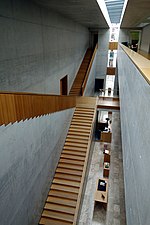
|

|
|
|
Georg Schäfer Museum (2000) with staircase hall
|
Kunsthalle Schweinfurt (2009) with exposed natural healing hill (1648)
|
The Georg Schäfer (1998–2000) Museum by Volker Staab is one of the most outstanding modern German museum buildings, with its staircase based on the model of the Alte Pinakothek in Munich. The opposite city library (2004-07) is a conversion and expansion of the Ebracher Hof (1431/1575), with a new underground base level (see picture: Libraries ). Together with the main customs office (2005–07), it forms a building ensemble that was selected by the German Architecture Museum in Frankfurt in 2008 as one of the 24 best buildings in Germany , in a symbiosis of tradition and modernity.
The Kunsthalle Schweinfurt (2008/09) is a renovation and expansion of the former Ernst-Sachs-Bad, with a 500 m² hall. The inner courtyard was built with a cellar for another exhibition room, with the remains of the so-called Naturheilschanze that Carl Gustav Wrangel had built in 1648.
The Stadtgalerie Schweinfurt (2007-09), with a 230 m long glass roof, is a 300 m long shopping mall in the classic sense, consisting of a single, straight shopping mall on two levels with a gallery. The technology center of Fresenius Medical Care (2019) in Hafen-West was designed by Gunter Henn , the architect of the Autostadt of Volkswagen in Wolfsburg and the Transparent Factory in Dresden.
Churches
St. Johannis (from 1200) is the oldest preserved building in the city, with a Romanesque core, Gothic transept, baptismal font from 1367 and paintings from the Middle Ages . The Kreuzkirche (13th century / 1940) in Oberndorf stands on the site of a medieval moated castle, the choir and tower were part of the castle chapel. St. Salvator (1717) in Zurich , with a Gothic choir (probably from 1412), also emerged from a castle chapel (around 1315). The Holy Spirit Church (1897–1902, neo-Romanesque ) has the shape of a Romanesque cathedral , with replicas of the Cathedral of San Vigilio in Trento ( crossing tower and choir). St. Kilian (1954) has one of the largest church windows in Germany (250 m²), created by Georg Meistermann . With the Church of the Resurrection (1959) on the Bergl , Olaf Andreas Gulbransson created the only major example of the new architectural style of ornamentation in exposed brickwork , which combines handicrafts and modernity . After Gulbransson's fatal car accident in 1961, this species was no longer found in other posthumously completed churches.
St. Johannis
(from 1200)
Romanesque
and GothicSt. Salvator
(1412/1717)
Gothic
and BaroqueHeilig-Geist-Kirche
(1897–1902)
Neo-Romanesque,
main portalSt. Kilian
(1954)
with 250 m² window
by Georg MeistermannChurch of the Resurrection
(1959)
am Bergl ,
by Olaf A. Gulbransson
Monuments and fountains
The Rückert monument (1890) on the market is a symbol of the city and commemorates the poet and orientalist Friedrich Rückert, who was born in Schweinfurt in 1788 .
In the ring system around the old town there are several monuments and fountains. A duplicate of the Great Beijing Wheel camp , the largest Ferris wheel in the world that has not been carried out, stands in front of the city theater . The roller weir monument is a replica of a chain hoist for the world's first roller weir from MAN (1903). The anchor is a monomental sculpture on the lock island . The Ludwigsbrunnen (1830) in honor of the Bavarian King Ludwig I stands at the foot of the historic vineyards on the old Mainleitenstrasse. The memorial for the victims of forced labor (2011) is a 3 km long former camp path in Oberndorf at the former forced labor camp of Kugelfischer . The German-American Air War Memorial (1998) on the bunker at Spitalseeplatz is the only monument of its kind in Germany. It is particularly reminiscent of Black Thursday , October 14, 1943, when the Americans suffered their greatest air defeat over Schweinfurt (see: National Socialism ).
City model
Since 2015, the Stadtschreiberhaus on Martin-Luther-Platz has had a model of the city showing Schweinfurt around 1800. It is to be extended to 4.80 meters in length up to the Peterstirn , which will then represent the historical city area with an extension of two kilometers.
See also: List of architectural monuments in Schweinfurt
Culture
In Schweinfurt, an alternative cultural scene has developed in addition to the conventional one since the 1980s . The city became a production facility for cultural workers and from the turn of the millennium into a supraregional center in the dance sector.
Theaters and stages
The theater of the city of Schweinfurt is one of the leading guest theaters in German-speaking countries. Many celebrities have already performed here, such as Jose Carreras , Ingeborg Hallstein , Heinz Rühmann , Marcel Marceau and others. Each season there are around 150 performances with artists from Germany and abroad on the program. The three venues are visited by over 80,000 people annually, including around 6,600 subscribers. Audiences also come from a wide area.
In the Disharmonie (Kulturwerkstatt am Main) theater, cabaret, music and art events take place. The cabaret Schrotturmkeller is located in the basement of a Renaissance house on the scrap tower in the old commercial district . The Hans Sachs Group maintains the late medieval carnival game and the Renaissance dance . There is also the Freundeskreis Puppentheater Schweinfurt .
Museums and galleries
The Georg Schäfer Museum (MGS) presents the most important private collection of 19th century German painting and the world's largest collection of Carl Spitzweg's works . Works by Caspar David Friedrich , Max Liebermann , Ferdinand Georg Waldmüller , Max Slevogt , Wilhelm Leibl and many others will also be shown. The Otto Schäfer Library is now part of the Otto Schäfer Museum (MOS) and contains around 1,000 illustrated prints, mainly from the 15th and 16th centuries, including the almost complete collection of Dürer's engravings. A second focus of the collection is the first editions of German literature from the Reformation period to Realism .
Four presentations take place in the Kunsthalle Schweinfurt every year, such as the Gunter Sachs Collection in 2014 , with works by Andy Warhol , Roy Lichtenstein , Salvador Dali and Max Ernst . The Kulturforum Martin-Luther-Platz, which is currently being planned (2020), will unite several historical buildings and currently closed museums. The German Bunker Museum in the Fichtel-und-Sachs-Bunker from 1941 is a history museum , military museum , war museum and memorial with events. The small museum is a private collection and shows graphic works by Hundertwasser , loans from German and international galleries as well as exhibits by Udo Lindenberg . The Gunnar-Wester-Haus presents the Graf Luxburg Collection , a cultural-historical collection on the development of fire generation and lighting since antiquity, and Fritz Glöckle's collection of icons . The Natural History Museum shows the Schuler brothers' bird collection. The Sparkassengalerie in the Schranne presents contemporary art in changing exhibitions. The Künstlerhof Oberndorf is located in the former home and studio of the artist Gustl Kirchner , with a Kirchner exhibition and Kirchner archive. The ZF Sachs Museum shows the Sachs exhibition of ZF Friedrichshafen AG on the industrial history of Fichtel & Sachs AG, with the three departments Corporate History , Technical Highlights , Marketing and Motorsport . The small industrial museum in the historic spinning mill on the Main shows exhibits from Schweinfurt's industrial history. The Saaz Local History Museum is located in a town house acquired by the Saaz Local History Museum Foundation at Oberen Straße 8. It shows an exhibition on life in Saaz (Žatec) until 1945, the expulsion of the Sudeten Germans and the reception of over 28,000 displaced persons and refugees in Schweinfurt.
- Famous pictures by Spitzweg in the Georg Schäfer Museum
See also: List of museums in Schweinfurt
music
orchestra
Schweinfurt is the second home of the Bamberg Symphony Orchestra - Bavarian State Philharmonic Orchestra , which gave their 500th concert in the city of Schweinfurt in 2019 . The Bläserphilharmonie Schweinfurt with professional musicians and experienced amateur musicians offers a large cast with full percussion the opportunity to work on programs with classical music , film music and arrangements of jazz and pop standards. Young musicians who are on the threshold of studying music play in the Schweinfurt Chamber Orchestra. The Kreisblasorchester Schweinfurt is an institution of the North Bavarian Music Association .
Choirs
The Thalia Choir was founded in 1860, at that time there was also acting. His current repertoire is pop , rock , musical , gospel and swing . The Singer Pleasure 1867 Schweinfurt has traditional songs as well as evergreens and modern songs in its repertoire. The Schweinfurt Concert Choir gives major concerts in the city theater and works with renowned symphony orchestras and soloists. Young Voices Schweinfurt was founded in 2006 and offers sacred and secular choral music of all ages and styles.
Pop and subcultural music
In 1988, a Monsters of Rock festival took place on the Oberndorf Mainwiesen in front of over 40,000 visitors. a. with KISS and Iron Maiden ; there were serious riots. Since the 1990s, bigger pop concerts with up to 25,000 visitors have taken place every summer in the Willy Sachs Stadium . a. the Backstreet Boys and Sunrise Avenue . The Stattbahnhof is a center for concerts, comedy and much more. The name was derived from the city train station, which is still in operation today (instead of a train station) , in whose former, historical ticket hall and the adjoining rooms the cultural center is located. The Stattbahnhof was voted one of the top 50 addresses in the German club scene in Visions magazine . Well-known names made guest appearances here, such as Marla Glen or Ten Years After .
Numerous bands have been founded in Schweinfurt since the 1980s, bringing rock, metal and punk albums onto the market. The Ghost Rockets (TGR for short) is a rock band; Albums: The Ghost Rockets (2009) and Goodbye Utopia (2014). Hatred (engl .: The Hass ) is a power and thrash metal band which in the Enzypedia the rock hard managed magazine; Albums: Soulless (2004), Madhouse Symphonies (2008), Destruction Manual (2010) and War of Words (2015). Vendetta is a thrash metal band; Albums: Go and Live… Stay and Die (1987), Brain Damage (1988), Hate (2007) and Feed the Extermination (2011). Kromlek was a metal band with anti-Christian symbolism, founded in 2004 and disbanded in 2012 . In 2005 their first major appearance took place at the Newcomer Festival in Schweinfurt, which they won, including playing at the Ragnarök Festival 2007; Albums: Strange Rumors… Distant Tremors (2007) and Finis Terrae (2011). Tagtraum emerged from the punk band Untergang , was founded in 1992 and decided to split up in 2006. The band members continue to play in other formations, Jörg Holdinghausen u. a. at We are heroes ; Albums Despite & Dreams (1997), Fire for Free (1998), Soul Puzzle (1999 ), Open Eyes and Through (2001) and Come on Let It Be Real (2003). In 2019 the indie rock band special stamp was founded with eight band members, with the former guitarist of Tagtraum Bernhard Wegner-Schmidt. Daniel Schnorr, also known as Jagi Lion King , mostly involved in hiphop and rap , released his first album I'm not here for you in 2020 .
Tonquadrat is a platform for electronic music . The music label in the Schweinfurt DDC Factory produces music of all kinds.
dance
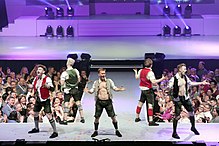
|
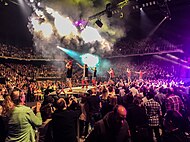
|
|
|
DDC from Schweinfurt
with breakdance in lederhosen |
DDC on tour
|
The Schweinfurt Dancefloor Destruction Crew (DDC), which was founded in 1999 and today mainly consists of full-time dancers, is one of the best breakdance groups in the world. In 2012 DDC won the triple, the TAF German Breakdance Championship, the IDO European Championship and, for the second time, the IDO World Championship. In 2013, DDC and the Berlin director and Echo Award winner Christoph Hagel combined classical music with breakdancing in their play Breakin 'Mozart , which has since been performed over 190 times in the Berlin Wintergarten Varieté and in many other cities. The company DDC Entertainment UG & Co. KG was founded, with the four divisions DDC Breakdance - DDC Production - DDC Workshops - DDC Agency . With the show Breakdance in Lederhosen in 2014 the idea of the crossover was finally established as a trademark of the DDC. The international breakthrough followed in 2015. DDC represented Germany in the 15th Wuqiao International Circus Festival in China and received a Special Price for Excellent Performance . The DDC-Factory in the district of Yorktown Village , with arena and studio, became a national dance center. In their specially produced radio show DDC TakeOver - Breakdancer OnTour , the dancers report on their 170 shows a year on the local youth broadcaster Radio Hashtag + .
The Dance Academy Schweinfurt was founded in 2006 with two locations, one in the city center and one in the Schweinfurt gymnastics community in 1848 . As an academy for amateur dancers and professional training for dancers, dance teachers and DTHO- hip-hop - dance teacher . The academy owns the formation Blazin 'Heat in the category professional league and since 2019 the formation Destiny Queens in the age category Juniors 1 .
Regular events
The Schweinfurt area is known for its high density of festivals, which also reflects the way of life of the residents not far from the area where wine francs and beer francs overlap (see also: Cultural characteristics ). There are countless traditional church fairs (Kerm) and wine festivals, to which many newer festivals have been added. On some weekends, several festivals and parish ceremonies take place in the city and the surrounding area at the same time, of which the festival calendar gives an overview.
Fair
The ufra (Lower Franconia Show ) is a regional trade fair for consumers and takes place every two years (in even years) in October on the Volksfestplatz. With over 400 exhibitors and 70,000 visitors in 22 halls, it is one of the larger regional fairs in Franconia .
Festivals
The Honky Tonk in Schweinfurt is the mother of the pub festivals, which was invented here in 1993. The annual, one-day honky tonk festival in around 40 pubs, mainly in the old town, attracted over 20,000 visitors in the beginning. The post-summer Schweinfurt music festival with international cast takes place every three weeks in September within the plants of large local companies, currently in the ZF boiler house. Well-known names such as Malia made guest appearances . The International Variety Festival is Europe's largest variety festival and takes place around every three years at Sennfelder See , for which a tent is set up.
District church consecration of the citizens' associations

The district civic associations in Schweinfurt have a special tradition and importance for the self-perception of the long-established population and their districts. The first chairman of the citizens' association is colloquially known as the district mayor. An exception is the Oberndorf Citizens' and Cultural Association , which was only founded in 1997, with his name and the waiver of a district mayor . There are a total of eight civic associations for the districts of Altstadt (not to be confused with today's old town ), Bergl , Deutschhof , Eselshöhe , Gartenstadt , Klingenbrunn , Oberndorf and Zürch .
All civic associations organize the district church fairs that are characteristic of Schweinfurt, with the exception of the Oberndorf civic association, which organizes several other types of festivals for this purpose. These are over 300 years, the Zurich fair in June in Zürch , the St Johannis church fair at the St. John's (24 June) on the Martin Luther Square and the Old Town's Fair at the city wall, on the Lower Wall, in mid-July.
The two largest traditional celebrations of the Schweinfurters are outside the narrow city limits. The Sennfelder and Gochsheimer Friedensfeste (church consecrations) , which take place at the same time around the first Sunday in September, in the two former imperial immediate and free imperial villages .
Other Events
The three Schweinfurt carnival companies ESKAGE , Schwarze Elf and Antöner Narrenelf present meeting evenings . On Shrove Tuesday, the traditional ESKAGE carnival parade leads through the city center, with around 25,000 visitors annually.
In April the first outdoor festival takes place, the bird's shot , a small folk festival organized by a shooting society. In May, Schweinfurt @ night invites you to a shopping and culture night . The Walpurgis Court on Corpus Christi is a medieval festival with a craft market in Friedrich-Pfister-Park in Oberndorf . On the Friday after Corpus Christi, the Schweinfurt Volksfest starts for eleven days as one of the largest Franconians. In May the spring wine festival and in July the summer wine festival of the Dahms winery take place on the otherwise inaccessible Peterstirn . The Schweinfurt Wine Festival takes place on the market square at the beginning of August, but not annually . At the end of August, the Schweinfurt City Festival will present “Enjoyment and quality of life in the region” on several squares in Schweinfurt's old town . The Medieval Festival is held every 3 years in September (most recently in 2019) on the city wall on the Unteren- and Oberen Wall. The Federweißer Festival GenussReichStadt Schweinfurt from the Dahms winery takes place at the same location at the end of September . At the street music festival Pflasterklang in September, musicians of all styles, jugglers, magicians and street painters perform at around 20 locations in the old town. The Night of Culture invites you to music, theater, dance, readings, cabaret and short films in places around the market square. The Schweinfurt Christmas market on the market square is limited to handicrafts and Christmas decorations. Traditionally, the Nuremberg Christ Child comes every year on his first visit away from home, with his prologue from the town hall balcony. Between Christmas and Epiphany, the Schweinfurt winter village is on the market square.
Culinary specialties
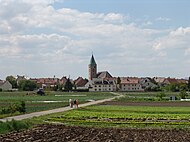
|
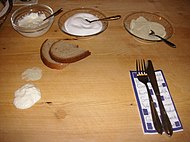
|
|
|
Schweinfurt butcher's bowl - cover: horseradish, salt, pepper, bread
|
Many direct marketers from the vegetable villages of Sennfeld and Gochsheim , on the outskirts of the city, with fresh goods at the weekly market in Schweinfurt are characteristic of the local cuisine . The city lies in the middle of the Slow Food Convivium Mainfranken-Hohenlohe , which is one of the largest regional groups of Slow Food Germany.
The original Schweinfurt butcher's bowl is a dish that the Schweinfurt butcher host Georg Josua Schwanhäusser first served his guests in 1856. The slaughter plate (Franconian: slaughter bowl ) is not found on any menu and is not a normal meal, but a party in good company over several hours for a larger group of people. The process follows a traditional ceremony, including traditional amusements. Sometimes with music and singing. The slaughter bowl of this type is only offered in taverns in and around Schweinfurt. The kettle meat is served on wooden boards up to five meters long, from which you can also eat. There is only black bread, horseradish and sauerkraut. Is drunk Franconian wine , wine spritzer or cider , beer is frowned upon.
The Meefischli (High German: the Mainfischlein ), tiny white fish that swim three times, in the Main, in the fat and then in the wine , are traditionally eaten like other fish only in the months with the letter r , i.e. from September to April. Blue corners are sour sausages in onion stock , which are mainly eaten in winter, including on Christmas Eve. The sweet ball bearing is the Schweinfurt alternative to Salzburg Mozart balls and is made by confectioners in the ball-bearing city : high-quality milk or dark chocolate made from pure cocoa butter is filled with a coordinated nougat cream.
nightlife
Local
The two classic bars were partly deserted for different reasons, while something new was emerging elsewhere.
The Niederwerrner Straße, a busy arterial road , offers a framework for street cafes in the middle area as an avenue with a front garden zone. From the 1960s onwards, a German-American boulevard developed here, mainly with ice cream parlors, pizzerias ( La Gondola since 1959) and nightspots, which was lively on beautiful summer days from afternoon until late at night. The closure of the US Army Garrison in Schweinfurt in 2014 brought a setback.
The 1990s were the heyday of the pub mile in the northern old town , where the pub festival was invented under the name Honky Tonk . The pub mile stretched from Obere Straße via Kornmarkt and Bauerngasse to the Zeughaus , with inns that were more than 100 years old in the core. The current (2020) ongoing renovation of the old town in this quarter should bring new impetus. Life partly shifted to the Obertor . The south-eastern old town has developed into a gastronomic quarter, especially in recent times, with older and newer restaurants of different standards and trendy bars of high quality, mainly bars and cafes.
Cinemas
In Schweinfurt, as elsewhere, there were numerous closings of film theaters . Nevertheless, the number of cinema halls increased by concentrating on a few locations. With 14 cinemas, the city now has a relatively high number of screens, twelve of which are on the eastern edge of the old town . The Imperial and Royal ( K ino u nd K neipe) in the Musicians district, is an award-winning cinema with two halls. The Weltbio Kino-Center from the 1950s was converted into a box cinema with five halls. Not far from there, the Filmwelt Schweinfurt opened in 2009 , a 3-D multiplex cinema with seven halls and a total of 1010 seats, where concerts and events are also broadcast live.
Discos
The local nightclub scene has changed in part since the Americans left in 2014. The 90 m long Megadrom am Hainig disco , which burned down in 2012 , was a self-proclaimed Hottest Hip-Hop Club of Germany and attracted an Afro-American and German-American audience from a wide area on Saturday evenings . Today the disco exists in a scaled down form as a Club 360 degrees . In the former Mad in Oberndorf , with a similar audience at the time, VIVA Club Rotation made two guest appearances at the end of the 1990s , moderated by Daisy Dee . The large discotheque, renamed Club Diamond , with two floors, became a German-Russian discotheque after the Americans left, like the Megadrom before . In addition to the Club 360 degrees lying Rockfabrik , also with two floors, has since the beginning of the era of techno kept unchanged and large nightclubs in the early 1990s to the present. The discotheque on Ludwigsbrücke , known as the Eastside, reopened in 2017 as a Pure Club & Lounge with various styles of music and parties. The former Suzie Club in Hafen-Ost saw itself as a noble disco and is now run as Aunt Suzie .
science and education
The place where the Leopoldina was founded
1652 was in the Imperial City of Schweinfurt , the German Academy of Sciences Leopoldina founded by four doctors and after Emperor I. Leopold named. It has been based in Halle (Saale) since 1878 . It is the oldest permanent science academy in the world. The foundation took place a few years before the corresponding societies in London ( Royal Society ) and Paris ( Académie des sciences ) were founded. In 2008 the Leopoldina was promoted to the National Academy of Sciences. The Friends of the Leopoldina , also based in Halle, hold their annual events every four years in Schweinfurt.
college for Applied Sciences
In the Schweinfurt department of the University of Applied Sciences Würzburg-Schweinfurt there are currently 2,858 students (WS 2019/20). The number of new students has more than doubled since 2007. The university was established in 1971 through the merger of the Balthasar Neumann Polytechnic in Schweinfurt with the Würzburg Higher Business School and Craft School. It is also called the Würzburg-Schweinfurt University of Applied Sciences (FHWS) and with a total of around 9,000 students is the fourth largest university of applied sciences in Bavaria. In 2011, Campus 2 was opened in Schweinfurt east of Campus 1.
i-Campus Schweinfurt
The FHWS is currently building the i-Campus Schweinfurt on the area of the former Ledward Barracks , as part of the internationalization of the university, which is called the FHWS i-Campus . The first English-language lectures for students from all over the world began in the 2014/15 winter semester on campus 1. A student village will be added where the first buildings have already been occupied. The Schweinfurt department of the FHWS has specialized in the MINT subjects , which is to be continued in the i-Campus . The additional projects i-Company and Industry on Campus provide for cooperation with companies and their direct access to research facilities at the university, right through to the merging of industry and university. In the final stage, the i-Campus will have 2,000 to 3,000 students.
Branch office of the Fraunhofer IPA
In 2019, the Fraunhofer Institute for Manufacturing Engineering and Automation (IPA) created a concept for a digital factory in the Schweinfurt i-Campus . The so-called i-factory is to become a research and transfer center for large-scale industry and medium-sized businesses. A branch of the Fraunhofer IPA was initially housed in the former Ledward Barracks in the former US headquarters in preparation for the project and is then to be relocated in a new building on site. As part of the i-factory concept, the FHWS is also introducing the first nationwide degree in Roboting in the i-Campus .
See also: Fraunhofer Institute for Manufacturing Engineering and Automation, i-factory Schweinfurt
Academic teaching hospital
The clinical center of the city of Schweinfurt Leopoldina Hospital (vernacular: Leo ) is the academic teaching hospital of the Julius Maximilians University of Würzburg . The Leo Academie offers employees and external participants further and advanced training programs in cooperation with other institutions, with lecturers from its own clinics and external teachers.
For more information on the Leopoldina Hospital, see: Health Care
schools

Of the eight state primary schools , three house a middle school . There is also a private elementary and middle school, which teaches according to Montessori pedagogy , two secondary schools and the private secondary and business school O. Pelzl. The five special needs schools offer different special needs.
Abitur , technical college entrance qualification or international Abitur can be obtained in nine schools: in five grammar schools (including Alexander von Humboldt grammar school , Olympia Morata grammar school and the Celtis grammar school founded in 1632 ) as well as in Bayernkolleg Schweinfurt , the technical college , the vocational school and the English-speaking International School Mainfranken . The private Lyceum of the Republic of Greece is a specialty . The school provider is the Ministry of Education of Greece and the school expense provider is the Republic of Greece.
Among the vocational schools, special mention should be made of the specialist academy for social education and the BDS trainee academy. The music school was founded in 1872 and is now one of the largest in Bavaria. Nationwide there were reports of incidents in the first private technical college in Schweinfurt that led to its closure.
Libraries

in the Ebracher Hof (1431/1575)
and in the new basement,
with skylights to the forecourt
- Library of the University of Applied Sciences Würzburg-Schweinfurt .
- Otto Schäfer Library
- Schweinfurt city library, central library in the Ebracherhof and branches in the Alexander-von-Humboldt-Gymnasium and Oberndorf .
Awards
The National Academy of Sciences Leopoldina awards the Carus Medal for outstanding scientific work . The Carus Prize of the city of Schweinfurt has been awarded to the winners of the medal since 1961 . It is named after Carl Gustav Carus , the 13th President of the Leopoldina founded in Schweinfurt.
The Friedrich Rückert Prize of the City of Schweinfurt is awarded every three years to outstanding writers.
The Erich-und-Erna-Kronauer-Stiftung (see: Foundations ) regularly awards a science prize for historians.
Foundations and Organizations
Foundations
There are 103 foundations in Schweinfurt (2013). The city has the highest number of foundations per 100,000 inhabitants nationwide (for reasons see also: Interesting facts , superlatives).
Schweinfurt Hospital Foundation
The largest and oldest foundation is the Schweinfurt Hospital Foundation, which is close to the city and whose beginnings must have been before the year 1364 and which must have had a fortune by 1417 at the latest. It maintains old people's homes and apartments for the elderly and owns forests near Schwebheim and Euerdorf as well as Gut Deutschhof , which was relocated to Grettstadt in 1977 . Their real estate is around 19 million euros.
Erich and Erna Kronauer Foundation
The Erich-und-Erna-Kronauer-Stiftung is a trust foundation and was founded in 1999 by Erich Kronauer and his wife Erna. The foundation is closely associated with the historian Ernst Nolte . The award of the Historians Prize to Stefan Scheil (2014), who emerged with historical revisionist theses and who is now a board member, led to a public controversy, at the latest in the course of which experts attested the foundation as a whole to be close to the New Right (see also: Awards ).
Organizations
German Association of Bechterew's Disease
The German Association of Bechterew's Disease is based in Schweinfurt, where it was founded in 1980. With over 16,000 patient and sustaining members, it is one of the largest patient organizations in Germany.
World Bicycle Relief
The international aid organization World Bicycle Relief has its European office in the Schweinfurt Main Valley , in the building of the bicycle component manufacturer SRAM .
economy
Schweinfurt has the third highest gross domestic product (2018) and with 76.2% (2017) the second highest in-commuter rate in Germany. 39,600 people commute to work in Schweinfurt every day. In 2017, the city had a total of 52,898 employees subject to social security contributions, almost as many as residents, including 26,823 in the manufacturing industry , around 17,750 in the service sector and 8,311 in trade , transport and hospitality . The superlatives and extreme values also have non-economic causes (see: Interesting facts , superlatives).
Well-known companies
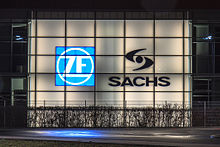
- Bosch Rexroth , Linear Motion Technology ; Headquarters in Lohr am Main
- Carl Kuehne KG ; Schweinfurt plant (on Sennfelder landmarks)
- Ewellix (formerly SKF Motion Technologies) linear motion technology; Headquarters in Gothenburg
- Fresenius Medical Care , the DAX Group 's largest production and development location, is in Schweinfurt; Headquarters in Bad Homburg
- Schaeffler KG (formerly DAX group FAG Kugelfischer ), second largest rolling bearing group in the world; The largest production site is in Schweinfurt, which is also the headquarters of the Industry division; Headquarters in Herzogenaurach
- Swedish ball bearing factories SKF , the world's largest rolling bearing group; the largest location is in Schweinfurt; Headquarters in Gothenburg
- SenerTec , European market leader for micro- combined heat and power systems
- SRAM (formerly bicycle components from Fichtel & Sachs ), European headquarters is in Schweinfurt; Headquarters in Chicago
- Winora-Staiger , bicycles
- ZF Friedrichshafen (formerly Fichtel & Sachs), the third largest automotive supplier in the world, the largest location is in Schweinfurt, and is also the headquarters of the E-Mobility division; Headquarters in Friedrichshafen
Large-scale industry
- Torpedo freewheel hub
from Fichtel & Sachs
- German head office of SKF
- Development center ZF Friedrichshafen
In 2019, over 22,000 people were employed in large-scale industry. Schweinfurt has been the European center of the rolling bearing industry since the 1930s . After initial difficulties in the 1970s with downsizing as a result of a Japanese dumping attack on the Schweinfurt rolling bearing industry, the city finally got into a serious crisis around 1992 as a result of globalization , which was overcome without plant closings. Since the 1990s, a change took place, away from cheaper mass production and dominant automotive supplies, to high-tech roller bearings for mining , shipbuilding , aviation and aerospace , large bearings for wind turbines and custom products such. B. the spherical roller bearing for the London Eye from FAG Kugelfischer. Research and development became more important and engineers replaced workers. There were also new industries, such as linear technology and medical technology with Fresenius Medical Care, with the world's largest production of dialysis machines . The i-Campus Schweinfurt , which has been under construction since 2017, is intended to intensify the collaboration between industry and universities, including: a. with the nationwide first degree in Roboting .
See also: Schweinfurt industrial history
Information technology
The GPSoverIP GmbH was founded in 2003 from a 1996 Schweinfurter IT forth -House. She developed the new method GPSoverIP for position transmission of geographical coordinates . It will u. a. Used in the logistics industry for trucks and Formula 1 racing cars. GPSoverIP GmbH works on behalf of well-known German companies such as Audi and BMW and is the award-winning industry leader. In addition, there has been close cooperation with the ADAC since 2008 .
The netlands edv consulting GmbH in Maintal was founded in 1999 and is in the area of software development and IT services business.
bb-net in Maintal was founded in 1996 and is an IT processor (processing of PCs, tablets and workstations).
Grafenrheinfeld , adjoining the Main Valley to the south , developed into an IT location, with two companies with a combined total of over 1000 employees (2020) (see: Grafenrheinfeld, company ).
Finance and Services
Several financial service providers are based in Schweinfurt. The Bankhaus Max Flessa (Brief description: Flessabank ) is a private universal bank headquartered in Schweinfurt and offices in three provinces. The Sparkasse Schweinfurt-Haßberge is a public credit institution . Mercator-Leasing is a subsidiary of two private banks (Bankhaus Max Flessa and Fürstlich Castell'sche Bank ). The SKD BKK is an open company health insurance fund for the ten West German federal states and Berlin . Unicredit operates a call center.
Other service providers are also worth mentioning. The German Telekom is also represented with a call center. The DB Fleet Service is with two of her German five DB car dealerships based in Schweinfurt. Dronesecure operates the first and so far (2019) only drone school in Germany.
Construction and real estate industry
Schweinfurt is the center of the construction and real estate industry in Main Franconia . The Riedel Bau group of companies with around 430 employees acts as a construction company nationwide and in project development and the implementation of property development projects with a focus on Main Franconia. The Glöckle group of companies with approx. 420 employees acts in the same way, also in civil engineering .
media
Publishers
Vogt & Fritz Verlag is a global sheet music publisher specializing in contemporary music. The book and idea publishing house has Schweinfurt as a thematic focus.
Newspapers

The two daily newspapers Schweinfurter Tagblatt and Volkszeitung belong to the Würzburg media group Main-Post , which has a monopoly in the field of print media in Mainfranken and belongs to the Pressedruck media group in Augsburg. Advertising papers are published by the Main-Post media group ( market and main Sonntag ) and the Schweinfurt-based SAZ-Verlag ( Schweinfurter Anzeiger and Sonntagsanzeiger ). Twice a year (May and November) the university's own magazine BLICK is published for students by the University of Applied Sciences Würzburg-Schweinfurt and the Julius-Maximilians-University Würzburg .
Online newspapers
The Main-Post media group has an online edition. Special online newspapers are Schweinfurt City / swity.de , the articles of which are taken over by the news magazine Focus in its Bavarian online edition, SW1.News and inFranken.de with a Schweinfurt edition.
broadcast
In 1991 Radio Primaton 'began as a private radio broadcaster . In 2017 the private radio broadcaster Radio Hashtag + was founded with the target group of 14 to 29 year olds. The Bayerischer Rundfunk (BR) has a studio (see television) and produces contributions from the Main-Rhön region for BR radio programs .
watch TV
Bayerischer Rundfunk's studio Main-Rhön in Schweinfurt produces reports from the region and broadcasts live reports for BR and ARD . TV touring Schweinfurt has broadcast a daily live program for Schweinfurt and the Main-Rhön region since 1990 from 5 to 6 p.m., which is then repeated every three hours. Since 2017 the station has been called TV Mainfranken , still with separate programs for Schweinfurt and Würzburg, including their regions.
Internet radio and television
Radio Hashtag + and TV Mainfranken can also be received over the Internet . Exclusive Internet TV offers SW-N.TV, with contributions from the city.
Tourism and conferences


In 2004 the Conference Center Maininsel (KMI) was opened on the Maininsel Bleichrasen together with a four-star hotel. In 2017, Schweinfurt had a total of 21 accommodation establishments, 1,547 guest beds, 130,375 guest arrivals (+ 3.7% compared to 2016) and 228,764 overnight stays (+ 1.5%), of which 32,902 were foreign guests. In 2019, around 1,700 people worked in the city's hotels and restaurants. Among the tourists are business travelers, conference participants, museum and bicycle tourists ( Main-Radweg ) and vacationers on the way to the south.
Schweinfurt is located in a tourist region, between the Bavarian state bath Bad Kissingen and the Volkacher Mainschleife . Together, this region has over 2 million overnight stays and over 200 accommodation establishments with around 10,000 guest beds. For larger conferences in Schweinfurt, hotels in Bad Kissingen must be used.
retail trade
The catchment area of the Schweinfurt retail trade has 759,000 inhabitants. The city can be reached in a maximum of one hour for the almost one million Main Franconians . The city has a very high retail centrality of 214 points (e.g. Würzburg 189 points, both values for 2019; see also: Worth knowing , superlatives). The sales area of Schweinfurt is 237,600 m² (2016). 70,200 m² of this is in the city center . The sales area density is a high 4,500 m² per 1,000 inhabitants (2016). In 2016/17, the vacancy rate was 9.9% (78 shops) among the around 800 shops in the city center and was therefore below the level of other regional centers overall. Only in the 1A locations were there an above-average number of vacancies.
In the city center are the largest inner-city department store in Lower Franconia , a branch of Galeria Kaufhof (1964) with around 10,000 m² of retail space, the Rückert Center (1973) with 21,000 m² and the largest inner-city shopping center in Main Franconia, the Stadtgalerie Schweinfurt (2009) 300 m long shopping mall with 22,500 m² sales area, 100 shops and 1,300 parking spaces.
In the east of the port , one of the largest agglomerations of specialty stores in Germany has been built in competition with the city center. However, the city does not allow any downtown-relevant goods offerings in the port. In 2009 XXXLutz opened two furniture stores of its brands XXXL Neubert and Mömax in the neighboring Maintal, with a total of 34,900 m² of sales area.
- Main business centers from west to east
City:
JägersbrunnenCity:
Georg-Wichtermann-Platz
additional
Cycles
In the birthplace of the bicycle (see: Article introduction), well-known companies in the industry are also based today. In addition to SRAM and Winora (see: Well-known companies ), Pexco , the Puello family from Schweinfurt, founded in 2017 , has two bike collections, including e-bikes, their new brands Raymon and Husqvarna Bicycles .
Plastics
Schweinfurt is headquartered Maincor , a manufacturer of plastic pipes , seat of Main plastic and Melaplast that melamine - laminates produced. KLT Hummel Plastic ( K unstoff L ager T echnik) mainly produces for the automotive industry (including commercial vehicles ). Customers include Daimler , Scania , ZF, Schaeffler and Continental . KLT also works with SKF in the field of plain bearings , for maintenance-free bearings such as those installed in large format in the Oosterschelde barrage .
Colours
In the historical center of the German paint factories (see: Schweinfurt industrial history, paints ) there is only the Deifel paint factory today .
textiles
PAC am Hainig and Maintal is a leading global manufacturer of multifunctional towels .
Food
The loess-rich Schweinfurt Gauland in the west of the district is a granary. High quality malting barley also thrives here . A grain mill , the Cramer Mühle and two malt factories are located in the city: Ireks , with its headquarters in Kulmbach , and the Günther Schubert malt house.
Breweries
Of a total of eleven breweries, only the Roth brewery still exists today (see: List of former breweries in Bavaria, Schweinfurt ).
logistics
Due to its central German and European location, Schweinfurt is an important logistics location . ZF Friedrichshafen and SKF have their German and European logistics centers here. DB Schenker offers all areas of logistics in and near the city at a total of three locations, from sea and air freight to trade fair logistics to art logistics. There are other logistics companies on both sides of the southern city limits, Schäflein alone has ten locations here.
Mineral oils

|
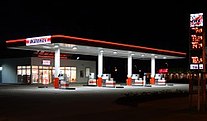
|
|
|
Erik Walther's push convoy ...
|
... and a Walther gas station
|
The mineral oil company Erik Walther has its headquarters in Schweinfurt, with a tank farm in the port . The company operates 70 own petrol stations in four states and shipped the mineral with its own tanker fleet from the ARA ports ( A msterdam- R otterdam- A ntwerpen) to the headquarters and other tank farms.
Agriculture and Forestry
1033 hectares in the urban area are used for agriculture . Two Aussiedlerhöfe are on the outskirts of the garden city and two on Münzberg . The viticulture comprises 3.5 ha (2017) on the Peterstirn (see: viticulture ). The water surface amounts to approx. 170 ha (2018), u. a carp ponds west of the Sennfelder See ; there are still some fish farmers . The forest areas cover 500 ha, which apart from smaller nature-protected and primeval forest-like zones on the southern bank of the Main are subject to forestry .
Incubators
The first business incubator was opened back in 1994, when G ründer- I nnovations- and B eratungszentrum S chweinfurt ( GRIBS ). In particular, it offers founders from the fields of information technology , software , technology and company- related services adapted office space on the Hainig for rent. The Maintal Opportunity Center, operated by the city of Schweinfurt, rents halls for start-up companies in the commercial sector in the Maintal industrial and commercial park . Since 2018, the city has also been offering coworking spaces in the Friedrich-Rückert-Bau in the old town , plus three external shops in the city center, as well as a startup opportunity center in the Heckenweg industrial park in the northern part of the city .
Infrastructure
Main bridges
Schweinfurt has a total of 62 bridges, including seven Main bridges that cross the Main or only individual arms of the Main or just the Altmain. Underneath is a railway bridge, all others are road bridges. The bridges listed below from east to west (downstream) completely cross the Main. The Maxbrücke is a three-lane road bridge, built in 1958. The city's first bridge over the main arm of the Main was in its place as early as 1400. The Gerolzhöfer Bridge is a single-track railway bridge on the Schweinfurt-Hbf – Kitzingen-Etwashausen railway line , which is currently not in operation, except for goods traffic in the Schweinfurt area. The first railway bridge at this point was built in 1903. The federal road 286 leads over the Hahnenhügel Bridge , which was built between 1964 and 1967 . With over 41,800 (2011) vehicles a day, it forms the main South Main access to the city center . It has four lanes and is to be replaced in a few years by a new five or six lane bridge. The Main Bridge Oberndorf is a six-lane road bridge (four lanes and two hard lanes), built in 1970/1994, on the federal motorway 70 . The bridge is also crossed by over 40,000 vehicles (2017) a day.
Federal waterway
Schweinfurt is located on the 3,500 km long large shipping route that connects the North Sea with the Black Sea via the Rhine-Main-Danube Canal . Every year 1,000 river cruise ships up to 135 meters long and 6,000 cargo ships pass through the city, including push convoys up to 180 meters long , mostly container or tankers. In the Schweinfurt area, the main navigation channel is currently being widened from 36 to 40 meters and deepened from 2.5 to 2.9 meters. The waterways and shipping authority Schweinfurt is one of 39 federal German waterways and shipping authorities (WSA) and is responsible for the federal waterway Main in the largest area of Lower Franconia over a length of 202 km. In 1911/1912, Schweinfurt was the end point of the chain shipping on the Main , which began in Mainz and was discontinued in 1936 due to insufficient profitability.
The ports Schweinfurt comprise a single port , a border , docks for passenger and cruise ships flow and marinas. The Schweinfurt run-of-river power plant is also located in the city , with a barrage and locks for ships and pleasure craft.
Public transport
Of all German cities, Schweinfurt has the densest network of public transport stops (for reasons see also: Interesting facts , superlatives).
Transport associations
The Transport Community Schweinfurt (VSW) is a transport association of local public transport for the area the independent town Schweinfurt and the district of Schweinfurt . 23 bus routes operated by local bus companies and two train routes operated by the Erfurt Railway and Deutsche Bahn offer a joint tariff. 2022 to the region Schweinfurt / Main-Rhön the Verkehrsverbunds MainFranken (VVM) are attached, the third largest population and to face the second largest traffic group of Bavaria.
rail
Railway stations:
- Schweinfurt main station ( category 3 )
- Schweinfurt Stadt railway station ( Category 5 )
- Schweinfurt Sennfeld train station (currently no passenger traffic)
- Schweinfurt Mitte stop ( Category 6 )
- Container Terminal Schweinfurt
In December 2028, Schweinfurt will be connected to the Intercity network through the new IC Bamberg – Schweinfurt – Stuttgart – Tübingen
Schweinfurt is on the following regional express (RE) and regional train lines (RB):
- RE Bamberg –Schweinfurt city – Schweinfurt center – Schweinfurt Hbf– Frankfurt am Main ; Paris -Est can be reached via this train from Schweinfurt with a single change in Frankfurt
- RE Würzburg –Schweinfurt Hbf – Bamberg– Nuremberg
- RE Würzburg – Schweinfurt Hbf– Erfurt
- RB Schweinfurt city – Schweinfurt center – Schweinfurt main station– Meiningen
- RB Schweinfurt city – Schweinfurt center – Schweinfurt central station– Bad Kissingen - Gemünden am Main
For a long time there have been initiatives to reactivate passenger traffic on the Kitzingen – Schweinfurt railway line . A direct long-distance connection from Schweinfurt to Fulda is also being discussed.
Central station around 1903
The station building was destroyed in 1943 and rebuilt further west after the warSchweinfurt Mitte
stop of the Deutsche Bahn (DB) and Erfurter Bahn (EB)Stadtbahnhof through station of the DB and terminus of the EB (in the picture on stump track )
buses
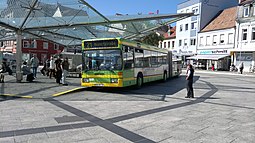
|

|
|
|
Articulated bus of the public transport company of the Schweinfurt public utility at the Roßmarkt central bus station
|
Scoreboard at the ZOB Roßmarkt
|
Central bus stations (ZOB):
- ZOB Bahnhofsplatz ( long-distance and regional buses )
- ZOB Roßmarkt ( city buses )
Long-distance buses from ZOB Bahnhofsplatz, with connections to many cities in Central Europe. Regional buses of Omnibusverkehr Franken (OVF) and VSW run to other stops in the city in addition to the ZOB Bahnhofsplatz. The OVF maintains one of three depots in Schweinfurt . City buses run by the public transport company of the Schweinfurt municipal utility run in a star shape to the Roßmarkt central bus station. 34 lines on a route length of 161 kilometers with approx. 8 million passengers (2016) serve the urban area and most of the suburbs.
Passenger shipping
The Schweinfurt passenger shipping company runs tours on the Main from March to October, also in connection with events with gastronomic offers on board.
Road traffic
The planning of the Reichsautobahn completely bypassed Schweinfurt (see: Route 46 and Route 85 ). As a result of the German division and the associated rescheduling and German reunification , the city finally became a motorway junction in the center of Germany (see: New Centrality ). At Schweinfurt, the A 70 as a southern bypass and the A 71 as a western bypass form a bypass around the city, with a total of seven junctions for the city and suburbs, which is why Schweinfurt has only 5% through traffic. The federal highways play only a minor role for Schweinfurt and were therefore partially downgraded to state highways . Schweinfurt is on the following highways:
-
 TEN Alta ( North Cape ) - Gela ( Sicily ). The European north-south axis, almost 5000 km in length, runs on the A 7 via the Schweinfurt / Werneck motorway junction .
TEN Alta ( North Cape ) - Gela ( Sicily ). The European north-south axis, almost 5000 km in length, runs on the A 7 via the Schweinfurt / Werneck motorway junction . -
 TEN Schweinfurt– Prague . It begins at the Schweinfurt / Werneck interchange. In the final stage, it was intended as a continuous, four-lane expressway from Schweinfurt to Prague, which is no longer possible due to the discontinuation of the planning for the Fichtelgebirgsautobahn in 2009.
TEN Schweinfurt– Prague . It begins at the Schweinfurt / Werneck interchange. In the final stage, it was intended as a continuous, four-lane expressway from Schweinfurt to Prague, which is no longer possible due to the discontinuation of the planning for the Fichtelgebirgsautobahn in 2009.

Thuringian Forest Autobahn A 71
Erfurt - Schweinfurt, under construction in 2002
-
 At the beginning of the 1960s, Schweinfurt received its first motorway connection Schweinfurt-Süd / Wiesentheid on the first motorway through Lower Franconia via a 34 km long motorway slip road . The junction later became meaningless for the city due to three new, closer motorways and therefore renamed Wiesentheid .
At the beginning of the 1960s, Schweinfurt received its first motorway connection Schweinfurt-Süd / Wiesentheid on the first motorway through Lower Franconia via a 34 km long motorway slip road . The junction later became meaningless for the city due to three new, closer motorways and therefore renamed Wiesentheid . -
 It runs from the Danish to the Austrian border. Junction points Wasserlosen (formerly Schweinfurt / Niederwerrn ) and Autobahn junction Schweinfurt / Werneck (A 7 / A 70). Between the Schweinfurt / Werneck junction and the A 3, the six-lane expansion began on five bridges, which should be completed by 2023.
It runs from the Danish to the Austrian border. Junction points Wasserlosen (formerly Schweinfurt / Niederwerrn ) and Autobahn junction Schweinfurt / Werneck (A 7 / A 70). Between the Schweinfurt / Werneck junction and the A 3, the six-lane expansion began on five bridges, which should be completed by 2023. -
 It starts at the Schweinfurt / Werneck motorway junction and runs via Bamberg to the Bayreuth / Kulmbach motorway junction (A 70 / A 9 ).
It starts at the Schweinfurt / Werneck motorway junction and runs via Bamberg to the Bayreuth / Kulmbach motorway junction (A 70 / A 9 ). -
 It ends at Schweinfurt at the Werntal motorway junction (A 70 / A 71) and begins at the Südharz motorway junction (A 71 / A 38 ).
It ends at Schweinfurt at the Werntal motorway junction (A 70 / A 71) and begins at the Südharz motorway junction (A 71 / A 38 ). -
 Eisenach - Little Walser Valley . It runs 2 km from the city limits as a western bypass and has been downgraded between the A 70 and Meiningen .
Eisenach - Little Walser Valley . It runs 2 km from the city limits as a western bypass and has been downgraded between the A 70 and Meiningen . -
 Riedstadt (Rhein) –Bamberg, was downgraded in the Schweinfurt area
Riedstadt (Rhein) –Bamberg, was downgraded in the Schweinfurt area -
 Autobahn junction Schweinfurt / Werneck - Arnstein . Federal road on a new route, without through-town traffic, but not free of intersections .
Autobahn junction Schweinfurt / Werneck - Arnstein . Federal road on a new route, without through-town traffic, but not free of intersections . -
 in the Federal Transport Infrastructure Plan 2030 . Planned expressway (three lanes with alternating fast lane) from the Schweinfurt / Werneck motorway junction to the A 3 ( Helmstadt junction ) as a direct connection from Schweinfurt to Frankfurt am Main via A 3 and Stuttgart via A 81 . The B 26n initially follows the route of the B 26a to Arnstein and then continues on the new route to Karlstadt am Main.
in the Federal Transport Infrastructure Plan 2030 . Planned expressway (three lanes with alternating fast lane) from the Schweinfurt / Werneck motorway junction to the A 3 ( Helmstadt junction ) as a direct connection from Schweinfurt to Frankfurt am Main via A 3 and Stuttgart via A 81 . The B 26n initially follows the route of the B 26a to Arnstein and then continues on the new route to Karlstadt am Main. -
 Enzlar - Bad Brueckenau . In the section between the A3 , Wiesentheid junction and Schweinfurt-Hafenkreuz intersection-free expressway. In this section from Gerolzhofen to the junction Schwebheim three lanes, with an alternating passing lane and from there to Hafenkreuz four lanes.
Enzlar - Bad Brueckenau . In the section between the A3 , Wiesentheid junction and Schweinfurt-Hafenkreuz intersection-free expressway. In this section from Gerolzhofen to the junction Schwebheim three lanes, with an alternating passing lane and from there to Hafenkreuz four lanes. -
 A 7 , junction Wasserlosen - Schirnding (Czech border near Eger ). Between the A 70 near Schweinfurt and the Coburg region on a new route, with no through-roads, but not free of intersections.
A 7 , junction Wasserlosen - Schirnding (Czech border near Eger ). Between the A 70 near Schweinfurt and the Coburg region on a new route, with no through-roads, but not free of intersections.
Bike paths
The city has a relatively dense network of cycle paths in the western area and is located on three long-distance cycle paths . The 600-kilometer Main Cycle Route was the first German long -distance cycle route to be awarded five stars by the General German Bicycle Club (ADFC). The city is also on the Main-Werra cycle path and the Werntal cycle path .
air traffic
Schweinfurt is located between Frankfurt Airport (118 km to the west) and Nuremberg Airport (85 km to the south-east). Because of this proximity, there is no regional airport in between , although around 1970 a regional airport was planned not far west of today's Schweinfurt / Werneck motorway junction . There are three airfields around Schweinfurt:
- Airfield : Airfield Haßfurt-Schweinfurt , im 25 kilometers away Hassfurt , is also served by larger aircraft.
- Special landing site : Schweinfurt-Süd airfield , with grass runway; for motor planes and gliders of the Aeroclub Schweinfurt e. V. and business jets and helicopters .
- Military airfield (unused since 2014): It had different names: Flugplatz Schweinfurt (1937–1945), Schweinfurt Air Base (1945–1948), Conn Barracks (until 2014).
power supply
The Stadtwerke Schweinfurt operate in the city and some surrounding municipalities a power grid , methane gas network , district heating network and cable network . The Stadtwerke are co-owners of the Schweinfurt run -of -river power station . All gas is bought in. District heating is obtained from the joint power plant Schweinfurt GmbH, which operates the joint power plant in Schweinfurt (GKS).

|

|
|
|
Schweinfurt joint power station (GKS) in the port
|
Grafenrheinfeld nuclear power plant (KKG) still in operation here, decommissioned in 2015
|
The Grafenrheinfeld nuclear power plant (KKG), which is 3.4 km southwest of the city limits, was decommissioned in 2015. The fuel element-free system is planned to run until the end of 2020, followed by nuclear dismantling by 2033 . After that, the conventional demolition of the buildings and cooling towers begins, which is expected to be completed by 2035. The Konrad shaft near Salzgitter is to receive the low and medium level radioactive substances as a repository . Since it is not yet available, a supply hall (BeHa) was built at the KKG. The high-level radioactive waste is stored in the interim storage facility built at the KKG in 2006 , the fuel element cask storage facility (BELLA). It has a term of 40 years. It is not yet clear where the radioactive waste will go to, as there is no central repository . The two buildings BeHa and BELLA will be the only thing that will be left of the KKG after the demolition. Dismantling and demolition are expected to cost 1.2 billion euros. So far (2020) E.ON has no concept of what should happen to the factory premises afterwards.
One of the most important German line nodes for high-voltage direct current transmission is located at the nuclear power plant and on the opposite bank of the Main near Bergrheinfeld . It remains in place and has been expanded since the beginning of 2015, as the end of the planned Suedlink power line , as the first major underground cabling project .
Public facilities
Healthcare
The Leopoldina Hospital (popularly: Leo ) is an urban emergency hospital of specialized care , with 2,000 employees, more than 700 regular beds , 15 bed leading departments, 6 institutes and 12 dialysis places . In 2019, the Leo was named “Top Regional Hospital” in a clinic comparison by the news magazine Focus . There is also a medical care center ( medical center ) and other institutes on campus .
The St. Josef Hospital is a Catholic hospital with 260 beds and 7 specialist departments. Not far from the hospital, in the former Dr. Knüpffer , is the palliative ward of the Josefskrankenhaus, which also has a larger medical center with seven specialist practices attached.
The day clinic for psychiatry in Schweinfurt is a branch with 20 beds of the hospital for psychiatry, psychotherapy and psychosomatic medicine at Schloss Werneck . The Mainfranken Eye Clinic in the Rückert Center carries out outpatient operations and treatments in the broad spectrum of ophthalmology . The outpatient rehabilitation center at Hainig deals with restoring and maintaining mobility.
In Schweinfurt there are 356 residents for every doctor, including psychotherapists . This is an average between the comparable neighboring cities of Bamberg (277, 1st place in Germany) and Aschaffenburg (392) (both 2018).
Authorities

The areas of responsibility of several authorities based in Schweinfurt sometimes extend far beyond the region. In the 1990s, the Bavarian State Office for Statistics was partially relocated from Munich to Schweinfurt. In 2020 the Bavarian state government announced another relocation of the authorities, a branch of the Munich tax office with 300 positions will be located in Schweinfurt from 2022/23.
|
|
police
- Police Inspectorate (PI) Schweinfurt. It is responsible for the independent city of Schweinfurt and the district of Schweinfurt , excluding the old district of Gerolzhofen . In addition, serious environmental crimes in the Main-Rhön region are processed centrally by PI Schweinfurt if necessary.
- Water police in Schweinfurt. It belongs to PI Schweinfurt and is responsible for 75 kilometers of the Main between Limbach ( Haßberge district ) and Gerlachshausen ( Kitzingen district ) as well as various bodies of water in the Main-Rhön region.
- Criminal Police Inspectorate (KPI) Schweinfurt. With approx. 455,000 inhabitants, it covers the entire area of the Main-Rhön region.
- Traffic Police Inspection Schweinfurt-Werneck ( Autobahn Police ). It is located at the intersection of the 7 , 70 and 71 motorways . Your area of responsibility for traffic, general police tasks and the fight against crime includes the federal highways in the Main-Rhön region.
Until the US Army Garrison in Schweinfurt was dissolved in 2014, there was also the US Military Police (MP) in Schweinfurt.
dishes
Schweinfurt belongs to the judicial district of the Bamberg Higher Regional Court . Schweinfurt is the seat of several courts from different instances . In the 1990s, a Bavarian regional court was partially relocated from Munich to Schweinfurt.
- Bavarian State Social Court , only Bavarian branch (headquarters in Munich)
- Schweinfurt District Court
- Schweinfurt District Court
- Labor Court, External Chamber of the Würzburg Labor Court
Correctional facility
In Schweinfurt there is a correctional facility (JVA) with 84 prison places. Here are Untersuchungshaft- and prison sentences in the primary and rule enforcement up to six months for the District Court Schweinfurt and imprisonment to the same extent for the district court district Gemünden completed. On the grounds of the prison in the old town , on the western city wall, a prison was first built in 1884, which was destroyed in the last war. From 1945 the bunker A4 ( Goethebunker ) in the Musikerviertel served as an emergency prison until 1957, until the current building was completed on its former site.
Youth welfare facility
Haus Marienthal is a youth welfare organization with almost 170 years of tradition. In 1849 Johann Hinrich Wichern , the founder of the Inner Mission , also visited Schweinfurt. He had built the Rauhe Haus in Hamburg to rescue neglected children. In 1854, on the initiative of Ludwig von Jan, the Schweinfurt orphanage and rescue house was inaugurated. Since 2000, all after-school care centers in the city of Schweinfurt have belonged to the Marienthal house. The formerly Protestant foundation school is still supported today by historical, Protestant suburbs ( imperial villages and imperial knighthoods ).
Fire brigades
There are several fire departments in the city . The Fire Service Standing on guard Schweinfurt , the Volunteer Fire Department Schweinfurt and the fire brigades of Schaeffler , SKF and ZF Friedrichshafen . In addition, there was an American fire department until the US Army Garrison in Schweinfurt was dissolved in 2014.
Sports
Schweinfurt was considered the city of sports . This term is still sometimes used, although the sport for decades does not play a regional role here anymore, one provided by minority sports such as netball apart.
societies

There are 76 sports clubs and company sports associations in the city (2020). However, as in many other places, several conventional sports clubs, especially those with soccer departments, were decimated by demographics and some had to be reorganized. Many tennis facilities were dismantled or neglected as a result of the competition from the golf boom .
The oldest association in town is the Bürgerliche Schützengesellschaft 1433 Freischütz von 1875 eV It probably existed before 1433. Even before gunpowder was invented , an association for crossbow shooters was established here . In the tradition of football city stands 1. FC Schweinfurt 05 (see: soccer ). The two largest clubs, however, are the gymnastics community Schweinfurt 1848 with around 3,000 members and outside of conventional sports clubs the Schweinfurt section of the German Alpine Club with over 4,000 members (2020), it operates the Schweinfurter Hütte in the Stubai Alps and the hut on the Haselstaude in the Schweinfurter Rhön and the DAV climbing center Schweinfurt. Other traditional clubs are the Schweinfurt Ruder Club Franken from 1882 and the 1st Cyclists Association in 1892 Schweinfurt . The ERV Schweinfurt should also be mentioned with its ice hockey team Mighty Dogs . The latter two clubs are also linked to the city's bicycle and roller-skate tradition, where bicycles , skateboards , inline skates and associated ball bearings were or are made. The sailing club Ellertshäuser See Schweinfurt (SCES) rounds off the range of water sports .
Willy Sachs Stadium
The Willy Sachs Stadium was opened as a public park in 1936, a week before the Olympic Games in Berlin . It has a Bauhaus-style grandstand . The entire complex, with its old trees, is a listed building . The name of the stadium was criticized nationwide because of the links between the stadium founder, Willy Sachs, and National Socialism . Heinrich Himmler and Hermann Göring , friends of Willy Sachs, were present at the inauguration .
At the beginning of the 1960s, when the Willy Sachs Stadium was still one of the largest sports parks in the Federal Republic of Germany, the plan was to build the Federal Center for Athletics there, but this was then realized in Hanover .
Soccer
1. FC Schweinfurt 05 provided Andreas Kupfer, the first captain of the national soccer team of the Federal Republic of Germany . On May 12, 1937, four days before the Breslau-Elf was born , Schweinfurt footballers put the entire runners up in a test match between the German national football team and Manchester City in the Willy Sachs Stadium, with Andreas Kupfer, Albin Kitzinger (both FC 05) and Robert Bernard (VfR 07 Schweinfurt). The greatest successes of FC 05 were reaching the finals for the German championship in 1939 and 1942 and in 1936 reaching the semi-finals in the Tschammerpokal , as the DFB Cup was then called. In the 1930s and early 1940s , FC 05 was number 2 in Bavarian football after 1. FC Nürnberg . From 1931 to the introduction of the 1st Bundesliga in 1963, FC 05 played in the top national league without interruption. Attempts to move up to the 1st Bundesliga failed twice in 1966 and 1975. In 1974 FC 05 became a founding member of the 2nd Bundesliga . In the 2001/02 season the club belonged to the second division for the third and so far last time. Since then he has played in various amateur leagues, currently (2019/20) in the Bavarian Regional Football League .

both from FC 05 ; the only Germans in the first world eleven in 1938
The Italian double world champion coach Vittorio Pozzo put together a European football selection for the first time , which played on October 26, 1938 at Highbury in London against England. In this first Weltelf in football history two German were represented, Andreas copper and Albin Kitzinger, both from FC 05th
The local rival VfR 07 Schweinfurt (VfR 07) played from 1939 to 1941 also in the top division, the Gauliga Bayern, in the stadium on Hutrasen . The greatest success of the club was in 1940 reaching the second main round in the Tschammer Cup, in which VfR 07 was eliminated by Rapid Vienna .
Schweinfurt hosted the Tunisian national team at the 2006 World Cup .
athletics
At the Olympic Games in Rome in 1960, elimination competitions were held for the first time for the all-German Olympic team . The athletics preliminary decisions between the Federal Republic and the GDR were determined in the Willy Sachs Stadium. The all-German Olympic flag was introduced for these Olympic Games ( black, red and gold with white Olympic rings in a red stripe).
additional
Ice and roller hockey
The two-time speed skating world record holder in the great four-way battle, Günter Traub , who coached the US national team in speed skating from 1969 to 1970, emerged from the ERV Schweinfurt ice skating and roller skating club. In the 1960s, ERV Schweinfurt was the center of German roller hockey and provided almost the entire national team. ERV is currently playing in the 2nd Bundesliga. The greatest successes of the ERV ice hockey team ( Mighty Dogs since 2003 ) were two seasons in the 2nd division south from 1994 to 1996 and the championship in the Oberliga Süd / Ost 2003.
Fistball
Fistball has always been popular in Schweinfurt. The 1972 World Fistball Championship and the 2012 Men's Fistball European Championship took place in the Willy Sachs Stadium.
Netball
The same applies to another fringe sport, basketball , for which the Schweinfurt area is even a German center.
Regatta course
The Franconian rowing club maintains a 1000 meter long regatta course on the Main . Along with the Olympic facility in Oberschleißheim, it is one of the two Bavarian regatta courses. In the even years the Bavarian rowing championships take place at the Olympic facility and in the odd years in Schweinfurt, where the German sprint championships and the German rowing day have already been held.
golf
The Schweinfurt Golf Club, with around 1000 members, is one of the city's largest sports clubs. He operates an 18-hole course, a public 6-hole short course and a public driving range in Löffelsterz in the Schweinfurt Rhön .
leisure
The "Stadtstrand Schweinfurt" is located in a main bastion on the Main promenade. At the Main Quay there are landing stages for river cruise ships, the Schweinfurt passenger shipping company (round trips) and a boat rental for "grill boats" (grilling on the boat). The weir systems stretch along the opposite, southern bank of the Main , with bathing facilities, boat harbors and restaurants.

|
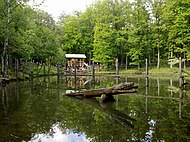
|
|
|
North of Schweinfurt ...
|
... with a wildlife park on the oaks
|
In the northeast of the city, the Schweinfurt Rhön , traversed by the valleys of the Zellergrundbach and Höllenbach , forms an extensive local recreation area with beer gardens and a dense network of hiking trails. With the up to 343 m above sea level. NHN rising, summer cool hair forest , the city forest, with the wildlife park on the oaks and the climbing hall of the German Alpine Club , the Silvana leisure pool, with a view over the silhouette of the city and the Höllental . The Peterstirn lies above the Mainleite, a bulging slope of the Main , with vineyards and a winery (wine festivals). There, the Beerhüterturm offers a view over the port area and the Schweinfurt basin on the ridge of the Steigerwald in all three Franconian administrative districts . A hiking trail leads from the Peterstirn through the steep slope of former vineyards, now a landscape protection area , to the Bismarckshöhe viewing platform with a view of Mainberg Castle (see: Location , top picture on the right).
In the south of the city, in the Schweinfurt basin 100 meters deeper, a swimming lake (26 hectares) is embedded in a recreational area at Schwebheimer Wald, with a 1 kilometer long beach, boat rental and high ropes course. (See also: Forests, Parks and Protected Areas )
Ice skating is possible on the natural ice rink at Ludwigsbrücke and in the Icedome at Willy Sachs Stadium . A toboggan run in the city forest leads down to the Zellergrundbach.
The listed leisure destinations are within a narrow city limit (for reasons see: incorporation ). Not far outside the southern city limits there are three more bathing lakes, u. a. the Sennfelder Seenkranz , which is closer to the city center .
Three long-distance hiking trails start in the city. A branch of the Lower Franconia Santiago route leads to Kreuzberg / Rhoen (928 m) to the Kreuzberg Monastery , one way to Schweinfurt House on Gangolfsberg (736 m) in the Rhön Biosphere Reserve and the Friedrich Rückert hiking trail from the birthplace of Friedrich Rückert on the market by the Haßberge by Neuses near Coburg . Schweinfurt is at the northeast end of Bocksbeutelstrasse , which leads along the Main to the center of the Franconian wine region, the Volkacher Mainschleife . Schweinfurt is located in a bathing region (see: location ).
useful information
Saddlery letter
The Schweinfurt industrialist Wilhelm Sattler was the first member of the Bavarian state parliament to speak out in 1847 for the standardization of fees and the introduction of postage stamps based on the English model, where the postage stamp had been introduced as early as 1840 with the one-penny unit postage . As a result, in 1849 the Kingdom of Bavaria became the first German state to issue postage stamps that could be stuck on. The Sattlerbrief from 1850 with postal characteristics was found in Schweinfurt in 2002 and is now in the Museum for Communication in Nuremberg .
Theodor Fischer: a father of the Bauhaus
The architect Theodor Fischer was born in Schweinfurt in 1862, where he grew up. He turned away from his collaboration (1886 to 1889) on the Berlin Reichstag building under Paul Wallot , distanced himself from historicism and was ultimately regarded as a father of modernism and the Bauhaus . His thoughts in the Manifesto for German Architecture became the basis for the Bauhaus Manifesto. In a speech in 1933 to the assembled Nazi celebrities, he appealed in vain for the preservation of the Bauhaus.
Invention of cordless football
In 1920 Fritz Stöcklein from Schweinfurt invented the cordless VAU-DE-Es soccer ball with a check valve.
First bodybuilding studio in Germany
The US-American Harry Gelbfarb was drafted into the army in 1951 and later stationed in Schweinfurt. After serving in the army, he met well-known bodybuilders in California and then opened Germany's first bodybuilding studio in Schweinfurt in 1956 . In 1959 he founded the first German bodybuilding association (DKB) with members of his studio. In 1981, Gelbfarb organized the first German championships in women's powerlifting in his Schweinfurt studio . For the first women's championships in bodybuilding, Gelbfarb helped formulate the guidelines. Yellow color has " initiated the modern age of this sport in Germany ". “ There were seven of them when Harry Gelbfarb founded the first German bodybuilding association in 1959. Half a century later there are seven million people in fitness studios training their strength with weights and machines ”.
Ludwig Mies van der Rohe and Schweinfurt
40 years before the opening of the Museum Georg Schäfer (MGS), the Schweinfurt industrialist Dr. Georg Schäfer asked the architect Ludwig Mies van der Rohe to plan a museum for his already important private collection. The design from 1960/61 envisaged a glass, column-free, single-storey hall space with a steel structure and was to be built in Fichtel's garden , a section of the northern Schweinfurt ramparts. The former SPD-dominated city council rejected the industrialist's gift for his hometown because of the maintenance costs that had to be taken over. Mies then realized the idea on a larger scale as the Neue Nationalgalerie in West Berlin from 1965 to 1968. It is the only building that Mies implemented in Germany after the Second World War. The construction management was done by his grandson Dirk Lohan, who was married to a daughter of Georg Schäfers. In 2017, Germany's only exhibition of Mies van der Rohe's collages took place at MGS next to his native Aachen , on loan from the Museum of Modern Art in New York City .
Gunter Sachs
Gunter Sachs was born in Mainberg Castle near Schweinfurt in 1932. He was known as the prototype of the gentleman playboy in the 1960s and 1970s . After his liaison with the Persian ex-Empress Soraya in 1962, he was married to the French film actress Brigitte Bardot from 1966 to 1969 . The photographer and art collector led post-war Germany out of its provinciality , made Pop Art socially acceptable and discovered Andy Warhol . Until the mid-1980s he was a member of the Supervisory Board of the Sachs Group in Schweinfurt. Around the turn of the year 2013/14, the Gunter Sachs collection was in the Kunsthalle Schweinfurt . a. with works by Andy Warhol, Roy Lichtenstein and Salvador Dalí . The exhibition saw itself “as a homage by the Sachs family to their roots”.
Nicknames and mottos
Schweinfurt has long been considered a ball bearing city (sometimes even: the world capital of ball bearings ). The city of Schweinfurt has recently stopped using the term because it negates the structural change towards more research and services, while it continues to be used pejoratively in the rival neighboring city of Würzburg . Industry and art have been featured on brown tourist information boards on the highways since the beginning of the 21st century . The nickname for 1. FC Schweinfurt 05 Schnüdel is only used in the city as a name for the club and in the surrounding area also as a nickname for the people of Schweinfurt . The name was derived from the lacing of football, which in turn made a Schweinfurter superfluous (see above).
Superlatives
Schweinfurt has numerous superlatives . The main reason for this lies in the lack of incorporation (see: incorporation ), which means that many statistical values refer to a comparatively small number of inhabitants. However, this also results in negative records in the social area, since the suburb is completely outside the narrow city limits. The (national) media are not aware of these causes, which is why the superlatives are almost always published as objective comparative values to other cities, without naming the background. While the city of Schweinfurt often cites positive superlatives, the political opposition likes to take up negative ones.
Schweinfurt
- is the smallest district-free city in Germany,
- has the highest job density in Germany (2015),
- has the densest network of public transport stops of all German cities ,
- has the most foundations per 100,000 inhabitants nationwide,
- 2015 had the most lightning strikes in Germany with 4.5 lightning strikes per square kilometer (see also: Climate ).
Personalities
From Schweinfurt originate Judith of Schweinfurt , (Queen of Hungary (?), Buried in St. Vitus Cathedral at Prague), Friedrich Rückert (poet and orientalist), Theodor Fischer (architect), Andreas copper , Albin Kitzinger (only German in the first Weltelf in football history 1938), Stefan Marquard (celebrity chef) and the "fallen star" Jürgen Höller (author and motivational speaker). Gunter Sachs (playboy, photographer, art collector and husband of Brigitte Bardot ) was born in the Schweinfurt suburb of Mainberg .
The city was also a center of attraction and part of the life of well-known people, such as Ernst Sachs (inventor and industrialist), Klaus Ernst (co-founder of the WASG and former chairman of the Left Party ) or Tommy Jaud (author). Ludwig Mies van der Rohe (architect), Michael Glos (politician) and Sarah Kreuz (singer) have family or professional connections to Schweinfurt .
- Personalities who were born in the city or are related to it
attachment
See also
literature
arranged alphabetically by author
- Heinrich Christian Beck : Chronicle of the city of Schweinfurt . British Library, London 2011, ISBN 978-1-241-41569-3 .
- Bruno Erhard: Schweinfurt, yesterday and today - in 55 pairs of historical and current photographs . Sutton Verlag, Munich 2019 (from May 22nd) ISBN 978-3-89702-020-7 .
- Friedhelm Golücke : Schweinfurt and the strategic aerial warfare 1943 . Ferdinand Schöningh, Paderborn 1980, ISBN 3-506-77446-8 .
- Hubert Gutermann: Alt Schweinfurt - in pictures, customs and legends . Schweinfurter Tagblatt, Schweinfurt 1991, ISBN 978-3-925232-09-1 .
- Thomas Horling, Uwe Müller, Erich Schneider: Schweinfurt: Small city history . Verlag Friedrich Pustet, Regensburg 2014, ISBN 978-3-7917-2609-0 .
- Martin Matl: Architecture Guide Schweinfurt - Buildings after 1945 . Verlag AIV, Architects and Engineers Association, Schweinfurt 2014, ISBN 3-00-045006-8 .
- Andreas Mühlich, G. Hahn: Chronicle of the city of Schweinfurt . Nabu Press, Berlin 2011, ISBN 978-1-247-00419-8 .
- Uwe Müller: Schweinfurt - over 200 views from the beginnings of photography up to the fifties . Sutton Verlag, Munich 2017, ISBN 978-3-89702-020-7 .
- Erich Schneider : Schweinfurt and its monuments - architecture-art-technology . Verlagshaus Weppert, Schweinfurt 2015, ISBN 978-3-9803695-9-6 .
- Friedrich Stein: History of the city of Schweinfurt together with a chronicle of the city of Schweinfurt . Verlag Rückert-Buchhandlung, Schweinfurt 1992, ISBN 3-9802305-2-X .
- Paul Ultsch: Back then in Schweinfurt - Volume 1 - When the city wall was still a boundary . Book and idea publishing house, Schweinfurt 1980, ISBN 3-9800480-1-2 .
- Paul Ultsch: Back then in Schweinfurt - Volume 2 - Development into an industrial city . Book and idea publishing house, Schweinfurt 1983, ISBN 978-3-9800480-2-6
Web links
|
Further content in the sister projects of Wikipedia:
|
||
|
|
Commons | - multimedia content |
|
|
Commons | - multimedia content |
|
|
Wiktionary | - Dictionary entries |
|
|
Wikisource | - Sources and full texts |
|
|
Wikiquote | - Quotes |
|
|
Wikivoyage | - Travel Guide |
- Official website of the city of Schweinfurt
- Literature from and about Schweinfurt in the catalog of the German National Library
- Schweinfurt: Official statistics of the LfStat
- Peter Hofmann: schweinfurtfuehrer.de
- Kathi and Romeo: Schweinfurt: Art, culture, young cafés & our tips
Videos
- TV 1 TV production: Schweinfurt from the air (03:58)
- 360: Schweinfurt and its waters from the air (02:53)
- Chronoshistory: The destroyed Berlin (00: 00–02: 00) and the destroyed Schweinfurt from the air (2: 00–6: 00)
- The History Channel: The Schweinfurt Raid . First air raid on Schweinfurt with heavy USAF losses on August 17, 1943 (45:26, in English)
- Royal Riches: Bye Bye Schweinfurt, Scenes from the West of Schweinfurt (02:36)
References and comments
- ↑ "Data 2" sheet, Statistical Report A1200C 202041 Population of the municipalities, districts and administrative districts 1st quarter 2020 (population based on the 2011 census) ( help ).
- ↑ a b c d e f g Dr. Wolf-Armin Freiherr von Reitzenstein, lecturer for Bavarian onomatology at the Ludwig Maximilians University in Munich , in: Peter Hofmann: schweinfurtfuehrer.de/Wo from where does the name Schweinfurt come from? Retrieved May 13, 2020 .
- ↑ Kilian Beck: Tax assessment policy and contribution planning: Empirical findings on taxes and contributions at the local level . Books on Demand, 2019, ISBN 978-3-95826-084-9 , pp. 119 ( books.google.de ).
- ↑ a b Citypopulation.de. Retrieved September 23, 2018 .
- ↑ a b According to the information provided by ECE Projektmanagement, the total catchment area of the Schweinfurt retail trade, based on the Stadtgalerie Schweinfurt location , has 758,974 inhabitants (2019)
- ↑ a b FOCUS: Poor city, rich city. A visit to the job paradise Schweinfurt and the debt stronghold of Oberhausen. Asg. No. 34, August 14, 2015. Retrieved July 26, 2017 .
- ↑ Two cities and a district are in front of Schweinfurt FAZ.de: Germany's improbable rising regions, April 10, 2018. Retrieved on August 9, 2018 .
- ↑ Wirtschaft in Mainfranken, August 2018, p. 63: SKF location Schweinfurt with approx. 4,100 employees, the largest location worldwide
- ↑ a b With the takeover of FAG Kugelfischer in 2001, Schaeffler became the second largest rolling bearing manufacturer in the world after SKF, in: Wirtschaft in Mainfranken: With a brilliant idea for a global corporation , August 2016, p. 78.
- ↑ a b manager magazin: ZF Friedrichshafen wants to become number 3 among automotive suppliers worldwide, March 29, 2019. Retrieved May 21, 2020 .
- ↑ In Ggs. Zu Pierre Michaux (1861) PM Fischer did not bring his invention exhibited in the Schweinfurt Museum for City History to the public, which is why he is still not mentioned in many sources on bicycle history. The alleged previous inventions by Baader (1825) and Heinrich Mylius (1845) are controversial and unproven: foelss.de: The development of the bicycle. Retrieved March 28, 2018 .
- ^ TNS Frankfurt Forum. Retrieved January 8, 2020 .
- ↑ a b Federal Ministry of Education and Research: National Academy of Sciences Leopoldina. Retrieved August 12, 2018 .
- ↑ SZ.de: The new center of the EU is in Lower Franconia, January 19, 2020. Retrieved June 28, 2020 .
- ↑ Nuremberg Airport , Frankfurt Airport , Erfurt Airport
- ↑ a b stepmap.de: Europe map with main latitude and longitude degrees. Retrieved July 29, 2020 .
- ↑ The confluence point is on the B 26a , 5 km west of the Schweinfurt / Werneck motorway junction ; See location here
- ^ Information brochure City of Schweinfurt. Weka Info-Verlag, Mering 2002, p. 15.
- ↑ Topographic map of the Bavarian State Surveying Office 1: 25,000, sheet 5927 Schweinfurt
- ↑ There are five health spas in the Main-Rhön region: Bad Kissingen (state bath ), Bad Bocklet (state bath ), Bad Brückenau (state bath ), Bad Neustadt and Bad Königshofen
- ^ Paul Ultsch: Back then in Schweinfurt . Buch- und Ideenverlag, Schweinfurt, ISBN 978-3-9800480-1-9 , p. 67 ff.
- ↑ welt.de: The A 71 is the most expensive motorway in Germany. Retrieved April 13, 2020 .
- ↑ Mittelrhein-Tageblatt: Rail traffic to Schweinfurt strengthened - DB plans IC connection. Retrieved January 14, 2020 .
- ↑ Information from the city of Schweinfurt. The areas of the new quarry ponds not yet included here were measured in the BayernAtlas
- ↑ mainpost.de: Climate change: In the urban forest, the spruce is the main loser, October 16, 2019. Accessed November 25, 2019 .
- ↑ mainpost.de: Trees by the roadside for a better climate in the city, July 2nd, 2019. Accessed on June 16th, 2019 .
- ↑ a b City of Schweinfurt / Figures, data and facts. Accessed December 31, 2019 .
- ↑ mainpost.de: The trees in the weir systems, December 3, 2012. Retrieved on April 19, 2020 .
- ↑ City of Schweinfurt / State Garden Show 2026. Accessed on July 8, 2020 .
- ↑ Bavarian State Institute for Viticulture and Horticulture (LWG) Veitshöchheim: Planted vineyards in the viticulture register on July 31, 2017
- ↑ mainpost.de: Back to wine, September 26, 2014. Accessed December 25, 2019 .
- ^ Dahms winery: Schweinfurt and the wine. Retrieved July 21, 2015 .
- ^ Bavarian State Institute for Viticulture and Horticulture: History of Franconian Viticulture
- ↑ a b Süddeutsche Zeitung, online edition of July 26, 2016: Germany's lightning capital, information from the lightning information service.
- ↑ Youth welfare plan of the city of Schweinfurt / overview map of the statistical districts. Retrieved April 25, 2020 . The bold borders only separate city districts, the thin borders both city districts and only districts. District 47 Zeilbaum was incorrectly not assigned to the Deutschhof district on the map.
- ↑ a b c Population register-based (with second residences) and population structure according to information from the city of Schweinfurt. Retrieved October 4, 2018 .
- ↑ Also repatriates.
- ↑ Referred to as Schweinfurt-Süd in the city administration's population statistics .
- ↑ Referred to as Schweinfurt-Süd-Hafen in the city administration's population statistics .
- ↑ mainpost.de: Renovation: Ten million for the SKF high-rise, January 17, 2014. Accessed December 8, 2018 .
- ↑ a b c Karl Treutwein : Unterfranken , p. 141
- ^ First edition of the Romwegkarte, 1500, by Erhard Etzlaub
- ↑ a b c d e f geodaten.bayern.de Monument list Schweinfurt / soil monuments. (PDF) Retrieved November 24, 2017 .
- ↑ mainpost.de: Schweinfurt districts: Feeling good on Eselshöhe, September 28, 2017. Accessed on May 10, 2020 .
- ↑ a b mainpost.de: Tief Keller am Fischerrain, November 8, 2016. Retrieved April 30, 2020 .
- ↑ a b Peter Hofmann: schweinfurtfuehrer.de/Geschichte. Retrieved June 12, 2020 .
- ^ Anton Oeller: The place names of the district of Schweinfurt. 1955, p. 52.
- ^ Peter Rückert: Land expansion and desertification in the high and late Middle Ages . P. 146.
- ↑ a b c mainpost.de: Schweinfurt: Band ceramists brought agriculture and cattle breeding, July 24, 2020. Accessed on July 24, 2020 .
- ↑ a b mainpost.de: The first Schweinfurt settlement was a fishing village, May 10, 2019. Accessed on May 11, 2020 .
- ↑ Location of the site in the Bavaria Atlas with marking. Retrieved May 11, 2020 .
- ↑ a b c d e f g h i j k l m Historical Lexicon of Bavaria: Schweinfurt, Reichsstadt. Retrieved May 12, 2020 .
- ↑ a b c d e Schweinfurt | City | Culture | Topics. Publication of the Schweinfurter Tagblatt and special edition for the Handelsblatt and ZEIT: Mikro-Schauplatz der deutschen Geschichte , May 20, 2009, p. 4 f.
- ↑ Peter Hofmann: schweinfurtfuehrer.de/Geschichte Schweinfurt from its foundation to the year 1200. Accessed on May 13, 2020 .
- ^ Information brochure City of Schweinfurt. Weka Info-Verlag, Mering 2002, p. 5.
- ↑ a b Peter Hofmann: schweinfurtfuehrer.de/Geschichte. Retrieved May 24, 2019 .
- ↑ Rudolf Endres: The role of the Counts of Schweinfurt in the settlement of northeast Bavaria. Yearbook for Franconian State Research 1972, p. 7 and Dr. F. Stein: The margravial house of Schweinfurt. P. 27 ff.
- ↑ Peter Hofmann: schweinfurtfuehrer.de/Die significant role of the Margraves of Schweinfurt from 973 to 1057. Retrieved on December 12, 2016 .
- ^ A b Hubert Gutermann: Alt-Schweinfurt . 12th revised edition. Mediengruppe Main-Post, Würzburg 2006, ISBN 3-925232-22-2 , p. 112 .
- ↑ a b Peter Hofmann: schweinfurtfuehrer.de/Geschichte 1200-1300. Retrieved May 6, 2018 .
- ↑ a b c d City map Schweinfurt with history and sights, printing and publishing house Weppert, Schweinfurt 2003.
- ^ Streiflichter on the church history in Schweinfurt . St. Johannis parish, Schweinfurt 1992.
- ^ Information brochure City of Schweinfurt. Weka Info-Verlag, Mering 2002, p. 6.
- ↑ Lower Franconian History, Volume 3. Echter Verlag Würzburg 1995.
- ↑ Territorial conditions in Lower Franconia 1792. (PDF) Retrieved on February 14, 2018 .
- ↑ Several authors: Great Atlas of World History . Lingen Verlag, Cologne 1987, map p. 79: Germany in 1648.
- ↑ Brief Stadtgeschichte Schweinfurt , p. 40.
- ↑ mainpost.de: Geldersheim: Displaced pastors, missing altars, July 24, 2019. Retrieved on August 6, 2019 .
- ^ Paul Ultsch: Back then in Schweinfurt . Book and idea publishing company, Schweinfurt, ISBN 3-9800480-1-2 , p. 10
- ^ Heinrich Christian Beck: Chronicle of the city of Schweinfurt . Schweinfurt 1836–1841, Vol. 1, section. 2, column 28.
- ^ A b Paul Ultsch: Back then in Schweinfurt . Volume 1: When the city wall was still a boundary . Book and idea publishing company, Schweinfurt 1982, ISBN 3-9800480-1-2 , p. 80
- ↑ Peter Hofmann: schweinfurtfuehrer.de/Geschichte 1700–1800. Retrieved April 27, 2019 .
- ↑ Uwe Müller: Schweinfurt - from the imperial free imperial city to the royal Bavarian city , in: Rainer A. Müller, Helmut Flachenecker, Reiner Kammerl (ed.): The end of the small imperial cities 1803 in southern Germany , supplement to the magazine for Bavarian national history, B 27, Munich 2007, 139-163; (Digital view)
- ^ TV Touring Schweinfurt, January 29, 2016.
- ^ Hubert Gutermann: Alt-Schweinfurt . 12th revised edition. Mediengruppe Main-Post, Würzburg 2006, ISBN 3-925232-22-2 , p. 86 ff .
- ^ Hubert Gutermann: Alt-Schweinfurt . 12th revised edition. Mediengruppe Main-Post, Würzburg 2006, ISBN 3-925232-22-2 , p. 45 .
- ↑ mainpost.de: Troubled times and storming the Schweinfurt harmony, April 28, 2019. Accessed on April 28, 2019 .
- ^ Peter Hofmann: schweinfurtfuehrer.de/Geschichte 1926–1945. Retrieved June 18, 2020 .
- ↑ dailymotion.com: The History Channel / 11-The Schweinfurt Raid
- ↑ Michael Bucher, Rolf Schamberger, Karl-Heinz Weppert: How long do we have to live in these fears? Printing and publishing house Weppert, Schweinfurt 1995, ISBN 3-926879-23-8 , p. 42 f.
- ^ Die Welt.de: The sinking of the US Air Force over Schweinfurt. Retrieved April 15, 2016 .
- ^ Second Schweinfurt Memorial Association. Black Thursday 10/14/1943. Retrieved April 15, 2016 .
- ^ Mathias Wiedemann: End of a 70-year neighborhood . In: Schweinfurter Tagblatt, September 19, 2014.
- ↑ Ron Mihalko, Forst : History of the US barracks in Schweinfurt
- ^ Information brochure City of Schweinfurt. Weka Info-Verlag, Mering 2002, p. 7.
- ↑ a b c d Information brochure City of Schweinfurt. Weka Info-Verlag, Mering 2002, p. 8.
- ↑ City of Schweinfurt / Population by denomination on December 31, 2017. Accessed on June 14, 2020 .
- ↑ Other or no religious communities 43.48% according to the city of Schweinfurt, of which 5.5% were deducted for Muslims (see previous note)
- ↑ In the cadastral plan of 1868 is Hall of the former Free Christian Church, now Theater "Concert Hall" drawn
- ↑ Uzuwe Müller: documents Jewish life in Schweinfurt. Publications of the city archive Schweinfurt 4, 1990.
- ↑ From the history of the Jewish communities in the German-speaking area / Schweinfurt. Retrieved August 12, 2020 .
- ↑ Evangelical Lutheran Deanery Schweinfurt: The Second Jewish Era: Modern Times: 1813–1942. Retrieved August 12, 2020 .
- ↑ Peter Hofmann: schweinfurtfuehrer.de/Geschichte des Jewish Leben in Schweinfurt. Retrieved August 12, 2020 .
- ^ Alemannia Judaica / Synagogue in Schweinfurt. Retrieved August 12, 2020 .
- ↑ TV Mainfranken: "Islam in Schweinfurt", January 23, 2015
- ↑ mainpost.de: There is also racism in the multicultural city of Schweinfurt, March 21, 2019. Retrieved on April 3, 2019 .
- ↑ mainpost.de: Deutschhof: "Diversity in Unity", January 24, 2018. Accessed April 24, 2020 .
- ^ Rand Mc.Nally: International Atlas . Georg Westermann Verlag, Braunschweig 2001, ISBN 3-07-500001-9 , p. 306.
- ↑ Schweinfurt: Official statistics of the LfStat
- ^ City of Schweinfurt: twin cities. Retrieved December 26, 2019 .
- ^ City of Schweinfurt: North Lanarkshire (formerly Motherwell, Scotland). Retrieved December 26, 2019 .
- ↑ Entry on the coat of arms of Schweinfurt in the database of the House of Bavarian History , accessed on September 6, 2017 .
- ↑ a b Hubert Gutermann: Alt-Schweinfurt , 9th edition, p. 1.
- ^ Peter Hofmann: schweinfurtfuehrer.de/Stadtwappen. Retrieved January 11, 2019 .
- ^ Heraldry of the world: Schweinfurt. Retrieved July 21, 2015 .
- ↑ a b mainpost.de: 1972: Why Schweinfurt came out almost empty with the regional reform, May 4, 2020. Retrieved on May 6, 2020 .
- ^ Wilhelm Volkert (ed.): Handbook of Bavarian offices, communities and courts 1799–1980 . CH Beck, Munich 1983, ISBN 3-406-09669-7 , p. 569 .
- ^ Peter Hofmann: schweinfurtfuehrer.de/1919 - Oberndorf becomes part of Schweinfurt - Oberndorf in the 20th century. Accessed December 1, 2019 .
- ↑ Peter Hofmann: schweinfurtfuehrer.de/Der water tower Oberndorf is today on the mountain. Retrieved December 2, 2019 .
- ↑ a b c Tourist Information Schweinfurt 360 °: Schweinfurt city map. Sights and tour . September 2009.
- ↑ BDA Prize Bavaria 2001 and Architecture Prize Concrete 2001.
- ↑ Schweinfurt City | Culture | Topics. Special edition of the Schweinfurter Tagblatt for the Handelsblatt and DIE ZEIT: The most beautiful entrée. P. 3, May 20, 2009.
- ^ Time Machine Architecture , Fourth Architecture Week of the Association of German Architects (BDA) in Schweinfurt 2008, p. 2.
- ↑ Schweinfurt city culture topics . Special edition of the Schweinfurter Tagblatt for the Handelsblatt and the ZEIT, p. 10 f.
- ↑ mainpost.de: Star architect plans for Fresenius, September 19, 2017. Accessed June 11, 2019 .
- ↑ Peter Hofmann: schweinfurtfuehrer.de/Stadtmodell Schweinfurt around 1800. Retrieved on February 6, 2016 .
- ↑ Schweinfurt | City | Culture | Topics . Publication of the Schweinfurter Tagblatt and special edition for the Handelsblatt and DIE ZEIT: Von kühner Süchternheit , May 20, 2009, p. 20.
- ↑ Guide to Bavaria: Information about the theater in the city of Schweinfurt
- ↑ Information from the city of Schweinfurt
- ↑ Peter Hofmann: schweinfurtfuehrer.de/Gunnar-Wester-Haus. Retrieved October 19, 2016 .
- ^ Economy in Mainfranken: Evidence of Industrial History , August 2016, p. 20 f.
- ↑ Peter Hofmann: schweinfurtfuehrer.de/Sachs-Ausstellung der ZF-Friedrichshafen AG. Retrieved October 19, 2016 .
- ↑ Peter Hofmann: schweinfurtfuehrer.de/Kleines Industriemuseum. Retrieved October 19, 2016 .
- ^ Peter Hofmann: schweinfurtfuehrer.de/Saazer Heimatmuseum. Retrieved October 19, 2016 .
- ↑ mainpost.de: Concert in the organ hall with the Schweinfurt Chamber Orchestra, October 21, 2016. Accessed April 22, 2020 .
- ↑ mainpost.de: Monsters of Rock Festival Schweinfurt. Accessed April 30, 2020 .
- ↑ mainpost.de: The rock monsters on the Mainwiese, August 27, 2018. Retrieved on April 22, 2020 .
- ↑ mainpost.de: “Special stamp”: New indie band in Schweinfurt, April 26, 2019. Accessed April 26, 2019 .
- ↑ mainpost.de: The somewhat different rapper from Schweinfurt, July 18, 2020. Accessed on August 2, 2020 .
- ↑ mainpost.de: Top gymnasts trained in the DDC Factory, July 4, 2019. Accessed July 4, 2019 .
- ↑ Schweinfurter Anzeiger: Radiohashtag + and DDC start cooperation , June 7, 2019
- ↑ mainpost.de: Dance Academy again victorious, May 15, 2019. Accessed July 4, 2019 .
- ^ Citizens' associations Schweinfurt. Retrieved April 20, 2020 .
- ^ Slow Food Germany / Mainfranken-Hohenlohe. Retrieved August 12, 2020 .
- ↑ Sweet ball bearings. Retrieved April 29, 2018 .
- ↑ Schweinfurter Tagblatt: Praise from Minister: “A strong cinema landscape” , December 3, 2018
- ↑ Schweinfurter Tagblatt: New large cinema opens on Wednesday , July 9, 2009
- ↑ Main-Post: Megadrom: Arsonists were at work , May 23, 2012
- ↑ a b c SW1.News: Sport für's Megadrom, January 10, 2015. Accessed December 7, 2018 .
- ↑ University of Applied Sciences Würzburg-Schweinfurt / data and facts. Retrieved July 6, 2020 .
- ↑ mainpost.de: The number of students in Schweinfurt, March 11, 2019. Accessed on March 11, 2019 .
- ↑ FHWS International. Retrieved August 14, 2018 .
- ↑ schweinfurter , citizen magazine of the city of Schweinfurt, 3rd edition, p. 19.
- ↑ a b Economy in Main Franconia. Journal of the Chamber of Commerce and Industry Würzburg-Schweinfurt: The "i-Dreiklang" of the FHWS , March 2014, p. 28 f.
- ↑ mainpost.de: The i-Factory should go into operation in 2020 - with Fraunhofer, July 2, 2019. Accessed on July 2, 2019 .
- ↑ Mission statement of the music school. Zweckverband Musikschule Schweinfurt, accessed on March 29, 2020 .
- ^ Peter Hofmann: schweinfurtfuehrer.de/Liste Schweinfurt schools. Retrieved December 12, 2016 .
- ↑ mainpost.de: Foundations in Schweinfurt. The list, December 3, 2006. Retrieved August 26, 2020 .
- ^ A b c mainpost.de: History of a Foundation: Bought Salvation, November 25, 2013. Accessed on August 23, 2020 .
- ↑ Friedrich Klein: Doubtful Prize (carrier). Jörg Friedrich . In: Tribüne , Vol. 49, H. 154 (2010), pp. 50–54.
- ↑ mainpost.de: Help from Schweinfurt: Mobile for school, job and health, February 20, 2020. Accessed on February 20, 2020 .
- ↑ The in-commuter rate of a place is the percentage of its in- commuters in relation to its population
- ↑ a b BR24: Study confirms Schweinfurt's great economic power, April 30, 2018. Accessed on January 21, 2020 .
- ↑ Information: Bavarian State Office for Statistics , as of June 30, 2017. The number of service jobs could only be approximated due to the lack of precise information due to confidentiality regulations
- ↑ Katharina Juschkat: SKF Motion Technologies becomes Ewellix. In: Electrical engineering. Vogel Communications Group, October 7, 2019, accessed June 19, 2020 .
- ↑ a b Handelsblatt: New start at 56 - This entrepreneur has big plans with e-bikes, July 10, 2018. Accessed on November 29, 2019 .
- ↑ mainpost.de: Bosch, SKF, Schaeffler: What the automotive crisis means for suppliers, November 28, 2019. Accessed July 24, 2019 .
- ↑ mainpost.de: Future technology: Awards for telematics developers from Schweinfurt, April 7, 2020. Accessed May 30, 2020 .
- ↑ openPR: ADAC builds on patented technology from Schweinfurt, April 30, 2009. Accessed on April 24, 2019 .
- ↑ Economy in Mainfranken, June 2020 issue, p. 60
- ↑ mainpost.de: bb-net in the Main Valley refreshes company IT and retrofits it, June 30, 2020. Accessed June 30, 2020 .
- ↑ mainpost.de: Drones over the SKF leisure area, March 15, 2018. Accessed April 28, 2019 .
- ↑ jobs.mainpost.de/Riedelbau Group. Retrieved April 30, 2019 .
- ↑ mainpost.de: Schweinfurt gets its own youth channel, April 21, 2019. Accessed April 24, 2019 .
- ↑ Radio Hashtag +: Schweinfurt now has its own youth radio. Retrieved October 15, 2017 .
- ↑ mainpost.de: Tagblatt visits broadcasting: Schweinfurt as media location, January 31, 2020. Accessed on April 14, 2020 .
- ^ City of Schweinfurt / tourism data on tourism on December 31, 2017. Accessed April 30, 2020 .
- ↑ swity.de: Tourism boom: 1,700 employees in Schweinfurt hotels and restaurants. Retrieved August 12, 2019 .
- ↑ inFranklen.de: More than 1.6 million overnight stays in Bad Kissingen, January 8, 2018. Accessed November 5, 2018 .
- ↑ inFranklen.de: Positive tourism balance in Volkach, January 2, 2018. Retrieved on November 5, 2018 .
- ↑ mainpost.de: Citymanager: "Schweinfurt still has room for improvement - and potential", April 10, 2019. Accessed April 10, 2019 .
- ↑ Figures from studies on retail in Mainfranken , published annually by the IHK Würzburg-Schweinfurt , with estimates for the current year, based on calculations by the Gesellschaft für Konsumforschung (GfK) and Michael Bauer Research GmbH
- ↑ Schweinfurter Tagblatt: Reviewer: Retail in the Center , January 31, 2017.
- ↑ mainpost.de: Many ways to save the city, December 17, 2017. Accessed on April 11, 2019 .
- ↑ Information on Galeria Kaufhof
- ↑ mainpost.de: Stainless steel and light for the parking garage at the Rückert-Centrum, May 10, 2019. Accessed on May 11, 2019 .
- ↑ mainpost.de: “No other Neubert house is so perfect”, August 21, 2009. Accessed April 10, 2019 .
- ↑ mainpost.de: Schweinfurt south: Plastic Hummel builds production hall, July 26, 2019. Accessed on July 27, 2019 .
- ↑ mainpost.de: PAC: Textiles from Schweinfurt are in fashion, April 5, 2018. Accessed June 20, 2019 .
- ^ Association of Schnackenwerth / History. Retrieved July 25, 2019 .
- ↑ a b Information brochure of the city of Schweinfurt, 6th edition 2002, p. 15
- ↑ mainpost.de: The Gründerkaufhaus becomes a new project, July 25, 2018. Retrieved on April 29, 2019 .
- ↑ Schweinfurter Tagblatt: Schweinfurt has 62 bridges , January 28, 2014
- ↑ Schweinfurter Tagblatt: What commuters and Schweinfurters should know now , April 20, 2017
- ↑ a b Schweinfurter Tagblatt: After the Max building of the Hahnenhügel Bridge , April 12, 2017
- ↑ mainpost.de: The port that connects the Main with rail and road, March 13, 2019. Accessed March 14, 2019 .
- ↑ mainpost.de: The Main is 40 centimeters deeper and four meters wider, January 29th, 2019. Accessed on January 30th, 2019 .
- ↑ a b mainpost.de: Schweinfurt even depends on Berlin, May 21, 2019. Accessed on May 23, 2019 .
- ↑ SW1.News: Network area expansion: Nahverkehr Mainfranken GmbH was founded a year ago. Retrieved December 22, 2018 .
- ↑ mainpost.de: Rails through the Rhön? May 28, 2018. Retrieved May 16, 2020 .
- ^ City of Schweinfurt / traffic structure data. Accessed April 30, 2020 .
- ↑ Information in the traffic development plan 2030 for the city of Schweinfurt
- ↑ mainpost.de: Construction sites on motorways: Where do you face traffic jams at the beginning of the holiday? July 23, 2019. Accessed July 23, 2019 .
- ↑ Economy in Mainfranken: Status overview: Projects Federal Transport Infrastructure Plan 2030 (BVWP) , October 2016, p. 69.
- ↑ TV Touring: Planning of the B 26n was slimmed down, from four to three lanes, March 18, 2016.
- ↑ n-tv.de: Main-Radweg excellent - five stars from the ADFC. August 27, 2008.
- ^ Economy in Mainfranken: "Dismantling in Grafenrheinfeld" , March 2019, p. 10 ff.
- ↑ Schweinfurter Tagblatt: This is how E.on wants to tear down the Grafenrheinfeld nuclear power plant. May 8, 2016.
- ↑ TV Touring Schweinfurt: SuedLink - TenneT publishes possible routes , September 27, 2016.
- ↑ Der Spiegel: This is where the new energy highway should run. 5th February 2014.
- ↑ mainpost.de: Leopoldina among the top hospitals in Germany, November 12, 2019. Accessed November 12, 2019 .
- ↑ mainpost.de: Medical care: Large gap between town and country, May 4, 2019. Retrieved on May 4, 2019 . The information has been converted to residents per doctor
- ↑ a b mainpost.de: 300 jobs: Parts of the Munich tax office come to Schweinfurt, July 30, 2020. Accessed on August 1, 2020 .
- ↑ mainpost.de: In the port of Schweinfurt, where the world arrives, August 26, 2016. Retrieved April 30, 2020 .
- ↑ Police Headquarters Lower Franconia: Criminal Police Inspection Schweinfurt. Accessed April 30, 2020 .
- ↑ Police Headquarters Lower Franconia: Traffic Police Inspection Schweinfurt-Werneck. Accessed April 30, 2020 .
- ↑ a b Bavarian State Ministry of Justice: Brief information about the Schweinfurt prison. (PDF) Supplement to the 2019 Annual Report. Accessed March 29, 2020 .
- ^ Peter Hofmann: schweinfurtfuehrer.de/Goethebunker. Retrieved May 15, 2018 .
- ^ Hubert Gutermann: Alt-Schweinfurt . 12th revised edition. Mediengruppe Main-Post, Würzburg 2006, ISBN 3-925232-22-2 , p. 91 .
- ↑ Turngemeinde Schweinfurt 1848 e. V. Accessed May 30, 2020 .
- ^ German Alpine Club / Section Schweinfurt. Retrieved May 30, 2020 .
- ^ German Alpine Club / Climbing Center Schweinfurt. Accessed May 31, 2020 .
- ↑ Frankfurter Allgemeine Zeitung: Only three steps are up, July 5, 2019. Accessed June 24, 2020 .
- ↑ Schweinfurter Tagblatt, December 18, 2010.
- ↑ Google Maps: Section of the city forest with network of hiking trails. Accessed December 31, 2019 .
- ^ Museum for Communication Nuremberg: "Sattlerbrief" is the winning item in the "100 Treasures of Home" competition. Retrieved February 9, 2020 .
- ↑ a b InFranken.de: The man who stole the ball from the ball, August 24, 2015. Retrieved January 8, 2020 .
- ↑ Jürgen Gießing / Jan Todd: The Origins of German Bodybuilding 1790-1970 , in: Iron Game History , Vol. 9. No. 2 (2005), p. 18.
- ↑ Harry Gelbfarb website. Retrieved February 1, 2017 .
- ^ Zeitmaschine Architektur , 4th Architecture Week in Schweinfurt, 2008, pp. 58–59.
- ^ Art The art magazine: Mies van der Rohe. The collages from MoMA. (No longer available online.) Archived from the original on March 1, 2017 ; accessed on February 28, 2017 .
- ↑ Hamburger Abendblatt, May 10, 2011.
- ↑ schweinfurter , citizens' magazine of the city of Schweinfurt, 3rd edition, p. 16.
- ↑ Torsten Brandenburg in: Coaching Report. Retrieved March 4, 2019 .





